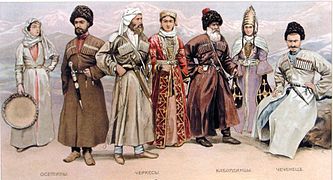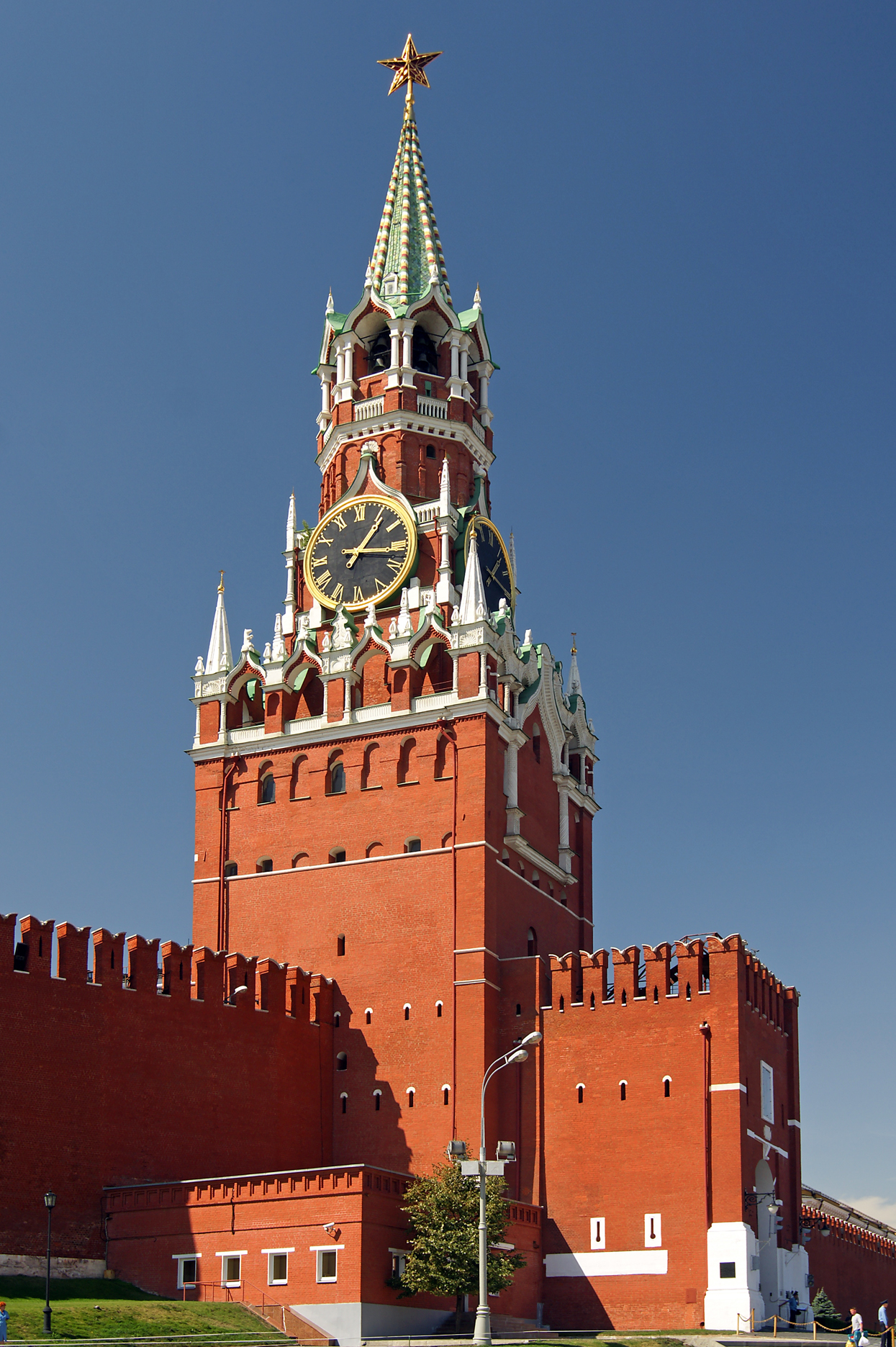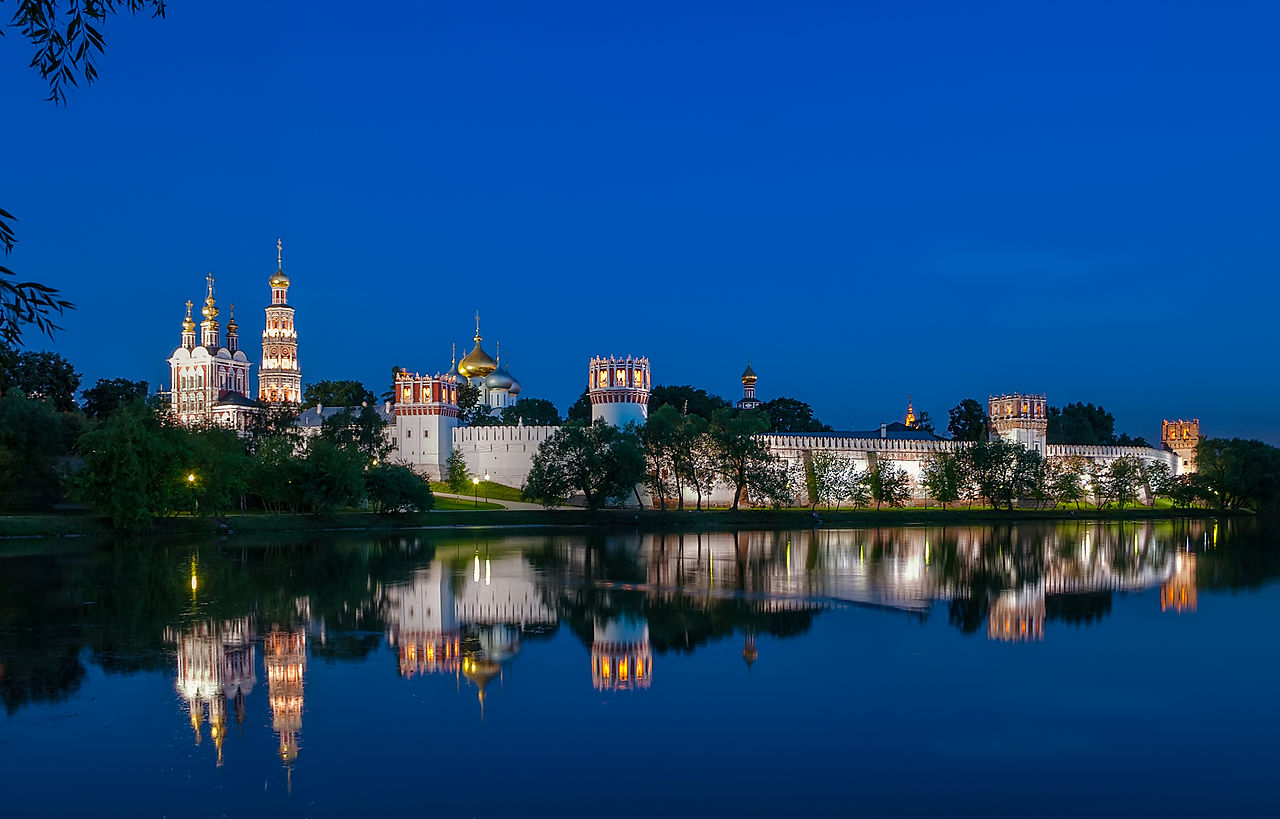Russia_Росси́я
Russia
Russian: Росси́я, tr. Rossiya, also officially known as the Russian Federation(Russian: Росси́йская Федера́ция, tr.Rossiyskaya Federatsiya; , is a country in northern Eurasia. It is a federal semi-presidential republic. At 17,075,400 square kilometres (6,592,800 sq mi), Russia is the largest country in the world, covering more than one-eighth of the Earth's inhabited land area. Russia is also the world's ninth most populous country with nearly 144 million people in November 2014.Extending across the entirety of northern Asia and much of Eastern Europe, Russia spans eleven time zones and incorporates a wide range of environments and land forms. From northwest to southeast, Russia shares land borders with Norway, Finland, Estonia, Latvia, Lithuania and Poland (both with Kaliningrad Oblast), Belarus,Ukraine, Georgia, Azerbaijan, Kazakhstan, China, Mongolia, and North Korea. It shares maritime borders with Japan by the Sea of Okhotsk and the U.S. state of Alaska across the Bering Strait.
The nation's history began with that of the East Slavs, who emerged as a recognizable group in Europe between the 3rd and 8th centuries AD. Founded and ruled by a Varangian warrior elite and their descendants, the medieval state of Rus arose in the 9th century. In 988 it adopted Orthodox Christianity from the Byzantine Empire,beginning the synthesis of Byzantine and Slavic cultures that defined Russian culture for the next millennium. Rus' ultimately disintegrated into a number of smaller states; most of the Rus' lands were overrun by the Mongol invasion and became tributaries of the nomadic Golden Horde in the 13th century.
The Grand Duchy of Moscow gradually reunified the surrounding Russian principalities, achieved independence from the Golden Horde, and came to dominate the cultural and political legacy of Kievan Rus'. By the 18th century, the nation had greatly expanded through conquest, annexation, and exploration to become the Russian Empire, which was the third largest empire in history, stretching from Poland in Europe to Alaska in North America.
Following the Russian Revolution, the Russian Soviet Federative Socialist Republic became the largest and leading constituent of the Soviet Union abbreviated to USSR, the world's first constitutionally socialist state and a recognized world superpower, and a rival to the United States which played a decisive role in the Allied victory in World War II. The Soviet era saw some of the most significant technological achievements of the 20th century, including the world's first human-made satellite, and the first man in space. By the end of 1990, USSR/Soviet Union had the world’s second largest economy, largest standing military in the world and the largest stockpile of weapons of mass destruction.
Following the partition of the Soviet Union in 1991, fourteen Independent republic nations emerged from the USSR(Armenia,Azerbaijan, Belarus, Estonia,Georgia, Kazakhstan,Kyrgyzstan,Latvia, Lithuania, Moldova, Tajikistan, Turkmenistan, Ukraine, Uzbekistan). The largest, most populous, and most economically developed republic, the Soviet Russia part of the USSR reconstituted itself as the Russian Federation and is recognized as the continuing legal personality (the sole successor state) of the Soviet Union.
The Russian economy ranks as the tenth largest by nominal GDP and sixth largest by purchasing power parity in 2015. Russia's extensive mineral and energy resources, the largest reserves in the world, have made it one of the largest producers of oil and natural gas globally.The country is one of the five recognized nuclear weapons states and possesses the largest stockpile of weapons of mass destruction.Russia was the world's second biggest exporter of major arms in 2010-14, according to SIPRI data.
According to the Fragile States Index of 2015 by Fund for Peace educational institution, Russia is in the 65th place in the "High Warning" section. High values of group grievance, human rights, security apparatus and factionalized elites indicators are major contributors to the overall index of Russia.
Russia is a great power and a permanent member of the United Nations Security Council, a member of the G20, the Council of Europe, the Asia-Pacific Economic Cooperation (APEC), the Shanghai Cooperation Organisation, the Organization for Security and Co-operation in Europe (OSCE), and the World Trade Organization(WTO), as well as being the leading member of the Commonwealth of Independent States (CIS), the Collective Security Treaty Organization (CSTO) and one of the 5 members of the Eurasian Economic Union (EEU), along with Armenia, Belarus, Kazakhstan and Kyrgyzstan.
-Dissolution of the Soviet Union:
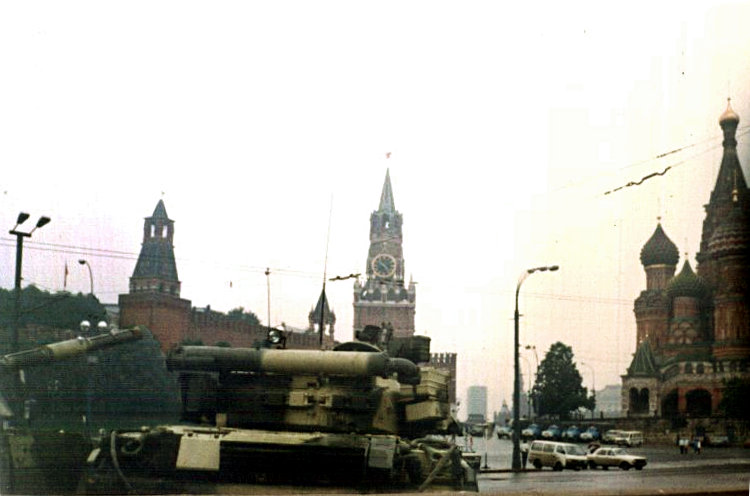
T-80UD tanks in the Red square during the 1991 soviet coup d'etat attempt. Location: Northern ramp of Bolshoy Moskvoretsky Bridge (not exactly Red Square, some 200 meters south from its formal southern edge, with Nabatnaya tower in sight)
-VIDEO :The Soviet Coup: Day One, August 19th 1991_On August 19th 1991, the Soviet people woke to news of an attempt to overthrow President Mikhail Gorbachev, the architect of "glasnost" and "perestroika". The coup, led by the so-called "Gang of Eight", brought Red Army tanks onto the streets of Moscow. Russian leader Boris Yeltsin led attempts to rebuff the coup plotters, and would go on to become the dominant force in Moscow as the Soviet Union crumbled and a restored Gorbachev lost his grip on power. Here you can watch Simon's Emmy-nominated coverage from Moscow on Day One of the coup for "World Monitor", the nightly newscast then produced for The Discovery Channel by The Christian Science Monitor
On December 8th, 1991, the three leaders of Russia, Ukraine and Belarus signed the document which marked the end of the Soviet empire. The fate of the great conglomerate country was decided in less than 24 hours.It happened in secret in a remote residence in the Belavezha forest. Soon the agreement entered the history as the Belavezha Accords. Visit the place where it happened and reveal the mysterious details of the document with the eyewitnesses to the historic event only on RT.
-VIDEO :Gorbachev Resigns: December 25, 1991

Post-Soviet states (alphabeticalorder) 1. Armenia 2. Azerbaijan 3. Belarus 4. Estonia 5. Georgia 6. Kazakhstan 7. Kyrgyzstan 8. Latvia 9. Lithuania 10. Moldova 11. Russia 12. Tajikistan 13.Turkmenistan 14. Ukraine 15. Uzbekistan
-VIDEO :A Very Russian Coup (documentary)_Playlist."A Very Russian Coup. August 19, 1991"
-VIDEO :A Very Russian Coup (documentary)_Playlist."A Very Russian Coup. August 19, 1991"
"Turning Points of History" series
Documentary film (1998)
Documents in detail the attempt of Soviet military leaders to seize control of the government in August of 1991, marking a turning point in world history and resulting in the dissolution of the Communist Party.
А. Малинин, Дорогой длинною - Original Russian version of 'Those Were the Days' by A. Kalinin:
-VIDEO :THOSE WERE THE DAYS MARY HOPKIN
-VIEW :Grand tour of Moscow, Russia_360° Aerial Panorama
-VIDEO : Russian Victory day Parade 2015
This is the parade in Moscow's Red Square, devoted to the 70th anniversary of the Great Victory over Nazi Germany in the Great Patriotic War (what the Eastern Front of World War II is called in the former Soviet Union), 9 May, 2015. Giving the commemoration speech is Russian President Vladimir Putin. Over 11,000 military personnel participated in this event. Presiding over the military parade in Minister of Defense of the Russian Federation, General of the Army, Sergei Shoigu.
The parade opened with solemn carrying of two flags, that of Russia and the historic banner that was raised over the Reichstag building back in 1945 to declare that it was taken by the Red Army.

Vladimir Vladimirovich Putin
-VIDEO :Vladimir Putin's presidential inauguration ceremony in Kremlin (2012)
Vladimir Vladimirovich Putin , born 7 October 1952) has been the President of Russia since 7 May 2012, succeeding Dmitry Medvedev. Putin previously served as President from 2000 to 2008, and as Prime Minister of Russia from 1999 to 2000 and again from 2008 to 2012. During his last term as Prime Minister, he was also the Chairman of United Russia, the ruling party.For 16 years Putin was an officer in the KGB, rising to the rank of Lieutenant Colonel before he retired to enter politics in his native Saint Petersburg in 1991. He moved to Moscow in 1996 and joined President Boris Yeltsin's administration where he rose quickly, becoming Acting President on 31 December 1999 when Yeltsin unexpectedly resigned. Putin won the subsequent 2000 presidential election, despite widespread accusations of vote-rigging, and was reelected in 2004. Because of constitutionally mandated term limits, Putin was ineligible to run for a third consecutive presidential term in 2008. Dmitry Medvedev won the 2008 presidential election and appointed Putin as Prime Minister, beginning a period of so-called "tandemocracy" In September 2011, following a change in the law extending the presidential term from four years to six,Putin announced that he would seek a third, non-consecutive term as President in the 2012 presidential election, an announcement which led to large-scale protests in many Russian cities. In March 2012 he won the election, which was criticized for procedural irregularities, and is serving a six-year term.
During Putin's first premiership and presidency (1999–2008) real incomes in Russia rose by a factor of 2.5, while real wages more than tripled; unemployment and poverty more than halved. Russians' self-assessed life satisfaction also rose significantly. Putin's first presidency was marked by high economic growth: the Russian economy grew for eight straight years, seeing GDP increase by 72% in PPP (as for nominal GDP, 600%). This growth was a combined result of the 2000s commodities boom,high oil prices, as well as prudent economic and fiscal policies.
As Russia's president, Putin and the Federal Assembly passed into law a flat income tax of 13%, a reduced profits tax, and new land and legal codes. As Prime Minister, Putin oversaw large-scale military and police reform. His energy policy has affirmed Russia's position as an energy superpower. Putin supported high-tech industries such as the nuclear and defence industries. A rise in foreign investment contributed to a boom in such sectors as the automotive industry.
Many of Putin's actions are regarded by the domestic opposition and foreign observers as undemocratic. The 2011 Democracy Index stated that Russia was in "a long process of regression [that] culminated in a move from a hybrid to an authoritarian regime" in view of Putin's candidacy and flawed parliamentary elections.In 2014, Russia was suspended from the G8 group as a result of its annexation of Crimea
-VIDEO : Moscow's empire - rise and fall _ DW Documentary
-VIDEO :Red Army Parade [1945 - English]_The Moscow Victory Parade of 1945
was a victory parade held by the Soviet army (with a small squad from the Polish army) after the defeat of Nazi Germany in the Great Patriotic War. It took place in the Soviet capital of Moscow, mostly centering around a military parade through Red Square. The parade took place on a rainy June 24, 1945, over a month after May 9, the day of Germany's surrender to Soviet commanders.
.
- Ethnic groups in Russia
-VIEW :Russia_ WikiVisually
-VIDEO :Russia - Joseph Stalin
-VIDEO :Adolf Hitler And Joseph Stalin - Roots Of Evil
-VIDEO :Socialism Documentary_playlist.
-VIDEO :Communism - The Promise and the Reality
-VIDEO :The Lost World of Communism
-VIDEO :The Bloody History of Communism Full
-VIDEO :Top Tracks - KOHAR Symphony Orchestra and Choir
-VIDEO :History of Russia (Tsars and Revolutions)
Le Livre noir du communisme : Crimes, terreur, répression (French)
-Estimated number of victims:
In the introduction, editor Stéphane Courtois states that "...Communist regimes... turned mass crime into a full-blown system of government". He claims that a death toll totals 94 million. The breakdown of the number of deaths given by Courtois is as follows:
- 65 million in the People's Republic of China
- 20 million in the Soviet Union
- 2 million in Cambodia
- 2 million in North Korea
- 1.7 million in Ethiopia
- 1.5 million in Afghanistan
- 1 million in the Communist states of Eastern Europe
- 1 million in Vietnam
- 150,000 in Latin America mainly Cuba
- 10,000 deaths "resulting from actions of the international Communist movement and Communist parties not in power."
Courtois claims that Communist regimes are responsible for a greater number of deaths than any other political ideal or movement, including Nazism. The statistics of victims includes executions, famine, deaths resulting from deportations, physical confinement, or through forced labor.
-READ: Black Book of Communism_
Crimes, Terror, Repression
-MOVIE:CHIẾN TRANH VÀ HÒA BÌNH - WAR AND PEACE - 1956
By 1812, Napoleon's forces controlled much of Europe. Russia, one of the few countries still unconquered, prepares to face Napoleon's troops together with Austria. Among the Russian soldiers are Count Nicholas Rostov and Prince Andrei Bolkonsky. Count Pierre Bezukhov, a friend of Andrei's and self-styled intellectual who is not interested in fighting. Pierre's life changes when his father dies, leaving him a vast inheritance. He is attracted to Natasha Rostov, Nicholas's sister, but she is too young, so he gives in to baser desires and marries the shallow, manipulative Princess Helene. The marriage ends when Pierre discovers his wife's true nature. Andrei is captured and later released by the French, and returns home only to watch his wife die in childbirth. Months later, Pierre and Andrei meet again. Andrei sees Natasha and falls in love, but his father will only permit the marriage if they postpone it for one year until Natasha turns 17. While Andrei is away on a military mission, ..
| Leo Tolstoy | |
|---|---|

Tolstoy in May, 1908, four months before his 80th birthday (photographed at Yasnaya Polyana by Sergey Prokudin-Gorsky; the first colour photograph taken in Russia)
|
-MOVIE:BÁC SĨ ZHIVAGO - DOCTOR ZHIVAGO - 1965
Lara inspires lechery in Komarovsky (her mother's lover who is a master at surviving whoever runs Russia) and can't compete with passion for the revolution of the man she marries, Pasha. Her true love is Zhivago who also loves his wife. Lara is the one who inspires poetry. The story is narrated by Zhivago's half brother Yevgraf, who has made his career in the Soviet Army. At the beginning of the film he is about to meet a young woman he believes may be the long lost daughter of Lara and Zhivago.
-SOMEWHERE, MY LOVE (LARA'S THEME):
- Beautiful RUSSIA :
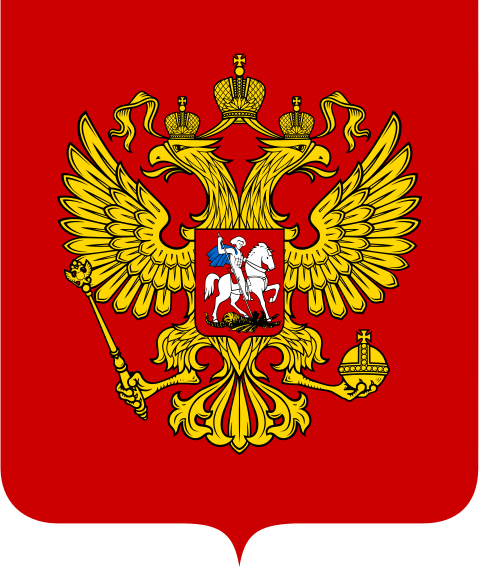
Coat of arms of Russia
-VIDEO :Russia_playlist
Saint Basil's Cathedral :
The original building, known as Trinity Church and later Trinity Cathedral, contained eight side churches arranged around the ninth, central church of Intercession; the tenth church was erected in 1588 over the grave of venerated local saint Vasily (Basil). In the 16th and 17th centuries the church, perceived as the earthly symbol of the Heavenly City,as happens to all churches in Byzantine Christianity, was popularly known as the "Jerusalem" and served as an allegory of the Jerusalem Temple in the annual Palm Sunday parade attended by the Patriarch of Moscow and the tsar.
The building is shaped as a flame of a bonfire rising into the sky, a design that has no analogues in Russian architecture. Dmitry Shvidkovsky, in his book Russian Architecture and the West, states that "it is like no other Russian building. Nothing similar can be found in the entire millennium of Byzantine tradition from the fifth to fifteenth century ... a strangeness that astonishes by its unexpectedness, complexity and dazzling interleaving of the manifold details of its design." The cathedral foreshadowed the climax of Russian national architecture in the 17th century.
As part of the program of state atheism, the church was confiscated from the Russian Orthodox community as part of the Soviet Union's anti-theist campaigns and has operated as a division of the State Historical Museum since 1928. It was completely and forcefully secularized in 1929 and remains a federal property of the Russian Federation. The church has been part of the Moscow Kremlin and Red Square UNESCOWorld Heritage Site since 1990. It is often mislabelled as the Kremlin owing to its location on Red Square in immediate proximity of the Kremlin.

Moscow, Kremlin. Bird's Eye View from the southwest.
Crossing the Moscow River,view of the buildings inside the Kremlin.
Grand Kremlin Palace

-VIDEO :The Kremlin and Red Square)2013)

360° Panorama of Red Square: Saint Basil (direction: SE), Kremlin with Lenin Mausoleum (from 1930) in front, State Historical Museum (NW) and GUM store. Hardly seen are Voskresensky gates just to the right of museum, Kazan Cathedral just to the left of GUM store and the Minin-Pozharsky monument in front of Saint Basil (originally it was in front of GUM store).

-VIDEO :Red Square in Moscow, Russia (February, 2013). "Real Russia"
The Moscow Kremlin (Russian: Моско́вский Кремль, tr. Moskovskiy Kreml; IPA: [mɐˈskofskʲɪj krʲɛmlʲ]), usually referred to as the Kremlin, is a fortified complex at the heart of Moscow, overlooking the Moskva River to the south, Saint Basil's Cathedral and Red Square to the east, and the Alexander Garden to the west. It is the best known of the kremlins (Russian citadels) and includes five palaces, four cathedrals, and the enclosing Kremlin Wall with Kremlin towers. The complex serves as the official residence of the President of the Russian Federation.
The name Kremlin means "fortress inside a city",and is often also used as a metonym to refer to the government of the Russian Federation in a similar sense to how the White House is used to refer to the Executive Office of the President of the United States. It had previously been used to refer to the government of the Soviet Union(1922–1991) and its highest members (such as general secretaries, premiers, presidents, ministers, and commissars). "Kremlinology" refers to the study of Soviet and Russian politics.
-VIDEO :Best of Moscow Aerial Drone flight
-VIDEO :Inside Kremlin: What's hidden from public eye? (RT Documentary)

The Tsar Cannon (Russian: Царь-пушка, Tsar'-pushka) is a large, 5.94 metres (19.5 ft) long cannon on display on the grounds of the Moscow Kremlin. It was cast in 1586 in Moscow, by the Russian master bronze casterAndrey Chokhov. Mostly of symbolic impact, it was never used in a war. However the cannon bears traces of at least one firing. Per the Guinness Book of Records it is the largest bombard by caliber in the world, and it is a major tourist attraction in the ensemble of the Moscow Kremlin.
-VIDEO :Blooming Apple Trees and Russian Ladies in Kolomenskoe, Moscow. "Real Russia"(2013)

Tsar Bell, Moscow (Kremlin)
The Tsar Bell (Russian: Царь–колокол, Tsar-kolokol), also known as the Tsarsky Kolokol, Tsar Kolokol III, or Royal Bell, is a 6.14-metre (20.1 ft) tall, 6.6-metre (22 ft) diameter bell on display on the grounds of the Moscow Kremlin. The bell was commissioned by Empress Anna Ivanovna, niece of Peter the Great.The present bell is sometimes referred to as Kolokol III (Bell III), because it is the third generation.
The Tsar Bell is located between the Ivan the Great Bell Tower and the Kremlin Wall. Made of bronze, the bell was broken during metal casting and has never been rung. The bell is currently the largest bell in the world,weighing 201,924 kilograms (445,166 lb), with a height of 6.14 metres (20.1 ft) and diameter of 6.6 metres (22 ft), and thickness of up to 61 centimetres (24 in). The broken piece weighs 11,500 kilograms (25,400 lb).
The bell is decorated with relief images of baroque angels, plants, oval medallions with saints, and nearly life-size images of Empress Anna and Tsar Alexey, who was reigning at the time the previous Tsar Bell was cast.
Spasskaya Tower with one of the Kremlin stars on top.(Spaskaja Bašňa (спасская башня) The Saviour tower)
The Spasskaya Tower (Russian: Спасская башня, translated as "Saviour Tower") is the main tower with a through-passage on the eastern wall of the Moscow Kremlin, which overlooks the Red Square.
The Spasskaya Tower was built in 1491 by an Italian architect Pietro Antonio Solari. Initially, it was named the Frolovskaya Tower after the Church of Frol and Lavr in the Kremlin (no longer there). The tower's modern name comes from the icon of Spas Nerukotvorny (The Saviour Not Made by Hands), which was placed above the gateson the inside wall in 1658 (it was removed in 1917) and the wall-painted icon of Spas Smolensky (Smolensky Saviour), which was created in the 16th century on the outside wall of tower (plastered over in 1937, reopened and restored in 2010). The Spasskaya Tower was the first one to be crowned with the hipped roof in 1624–1625 by architects Bazhen Ogurtsov and Christopher Galloway (a Scottish architect and clockmaker). According to a number of historical accounts,the clock on the Spasskaya Tower appeared between 1491 and 1585. It is usually referred to as the Kremlin chimes (Кремлёвские куранты) and designates official Moscow Time.
The tower gate was once the main entrance into the Kremlin. In czarist times, anyone passing through the gates had to remove their headgear and dismount their horses. This tradition was broken in the soviet era. Cars approached the gate head on from the place of skulls and the road beside GUM. In order to pass through the gate, you had to be a head of state, top politburo member, or top government member. All other traffic was routed through the borovistky gate. The spassky gate posed an issue following the collapse of communism. In the new capitalist and market based economy, the passage of vehicles disrupted the flow of pedestrians to GUM and other shopping centers, even though few vehicles actually passed through the gate each day. In 1999, the decision was made to finally close the gate to all traffic. The signal lights and guard platforms still remain. The gate is used occasionally when repairs must be made to the borovissky gate. However, in that case, all traffic is routed from vasilievsky spusk. Nowadays, the gate opens to receive the presidential motorcades on inauguration day, for the victory parades, and to receive the new years tree.
On top of the gates of the tower there was inscribed the following inscription: IOANNES VASILII DEI GRATIA MAGNUS DUX VOLODIMERIAE, MOSCOVIAE, NOVOGARDIAE, TFERIAE, PLESCOVIAE, VETICIAE, ONGARIAE, PERMIAE, BUOLGARIAE ET ALIAS TOTIUSQ(UE) RAXIE D(OMI)NUS, A(N)NO 30 IMPERII SUI HAS TURRES CO(N)DERE F(ECIT) ET STATUIT PETRUS ANTONIUS SOLARIUS MEDIOLANENSIS A(N)NO N(ATIVIT) A(TIS) D(OM)INI 1491 K(ALENDIS) M(ARTIIS) I(USSIT) P(ONERE).(Ivan Vasiliyevich, by the grace of God Grand Duke of Vladimir, Moscow, Novgorod, etc. etc.)
In 1935, the Soviet government installed a red star instead of a two-headed eagle on top of the Spasskaya Tower. The height of the tower with the star is 71 m. In August 2010 the icon of Smolensk Saviour was uncovered and restored above the gate.

is the main tower with a through-passage on the eastern wall of the Moscow Kremlin, which overlooks the Red Square.

The Ivan the Great Bell Tower (Russian: Колокольня Ивана Великого) is the tallest of the towers in the Moscow Kremlin complex, with a total height of 81 metres (266 ft). It was built in 1508 for the Russian Orthodox cathedrals in Cathedral Square, namely the Assumption, Archangel and Annunciation cathedrals, which do not have their own belfries.

Red Square (Russian: Красная площадь, tr. Krásnaya Plóshchaď; IPA: [ˈkrasnəjə ˈploɕːətʲ]) is a city square (plaza) in Moscow, Russia. It separates the Kremlin, theformer royal citadel and currently the official residence of the President of Russia, from a historic merchant quarter known as Kitai-gorod. Red Square is often considered the central square of Moscow, because Moscow's major streets—which connect to Russia's major highways—originate from the square
-VIDEO :Moscow Tour: Red Square, Kremlin

Saint Basil's (finished 1561)
The Cathedral of Intercession of the Virgin on the Moat (Собо́р Покрова́, что на Рву) also known as the Cathedral of Saint Basil the Blessed (Храм Васи́лия Блаже́нного) on the Red Square, Moscow.
The Cathedral of Intercession of the Virgin on the Moat (Собо́р Покрова́, что на Рву) also known as the Cathedral of Saint Basil the Blessed (Храм Васи́лия Блаже́нного) on the Red Square, Moscow.
-VIDEO :Saint Basil's Cathedral in Moscow. "Real Russia"(2013)

The Red Square, view from northwest, showing St Basil Cathedral and the Saviour Tower_14 July 2011
-VIDEO :Popular GUM & Saint Basil's Cathedral videos
-VIDEO :Russia Real Russia_playlist.

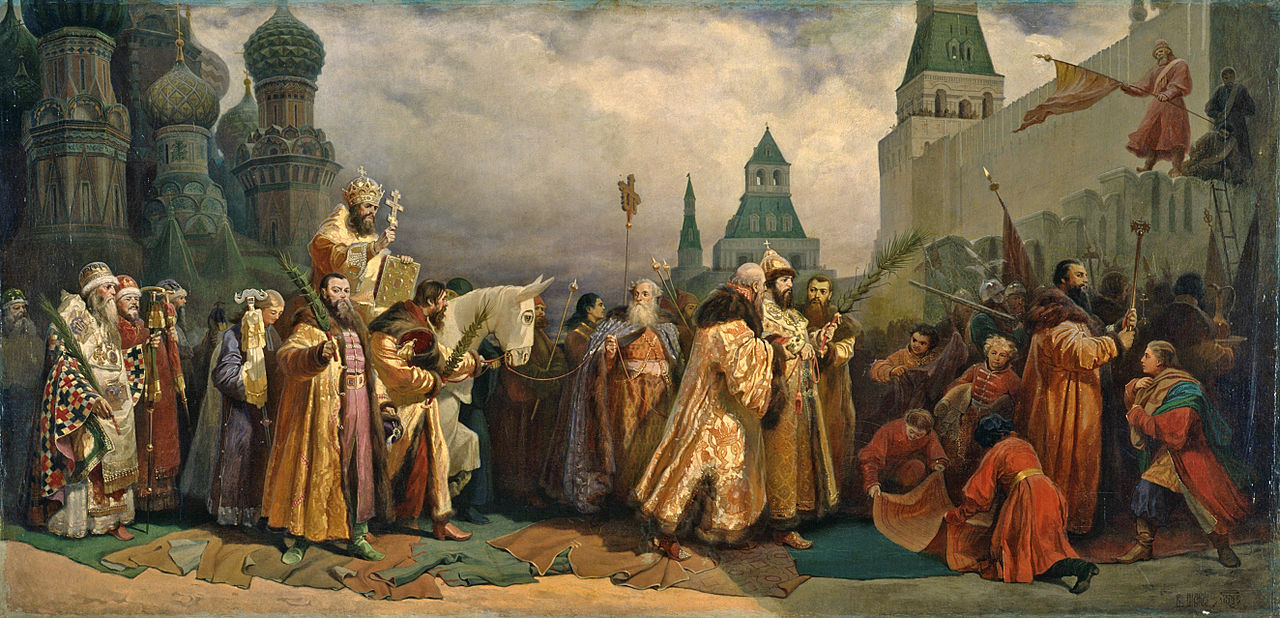
17th century Palm Sunday procession leaving Saint Basil for Kremlin.
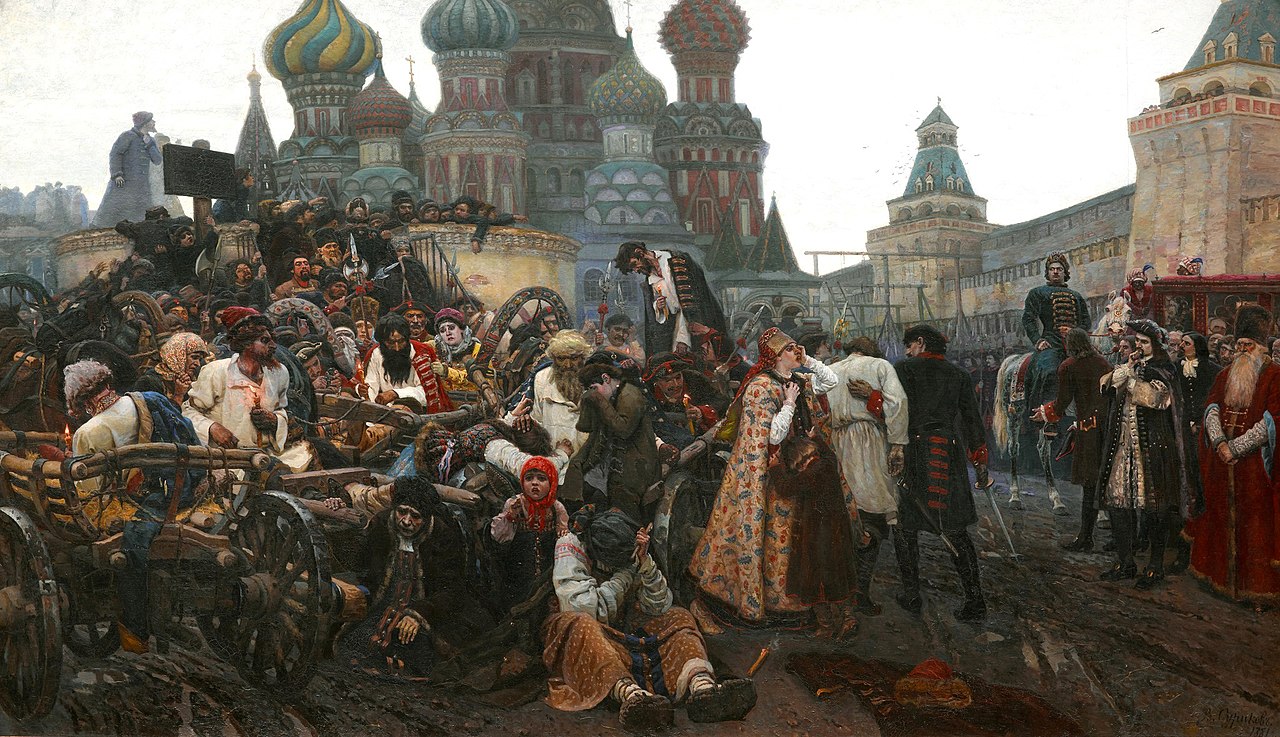
-VIDEO :The Tragic Story Behind St. Basil's Cathedral

Saint Basil's Cathedral, Red square, Moscow
-VIDEO :St. Basil's Cathedral: Ginger castle on Red Square

Color scheme of the cathedral is best seen by night.

Monument to Minin and Pozharsky
The Monument to Minin and Pozharsky (Russian: Па́мятник Ми́нину и Пожа́рскому) is a bronze statue on Red Square in Moscow, Russia, in front of Saint Basil's Cathedral. The statue commemorates Prince Dmitry Pozharsky and Kuzma Minin, who gathered an all-Russian volunteer army and expelled the forces of the Polish-Lithuanian Commonwealth under the command of King Sigismund III of Poland from Moscow, thus putting an end to the Time of Troubles in 1612.Originally, the statue stood in the centre of the square, with Pozharsky waving his hand towards Moscow Kremlin, but in 1936, the statue was moved nearer to the cathedral.
Original Location of Monument to Minin and Pozharsky

Kazan Cathedral (1993 reconstruction, it originates back to 1612-25)Rebuilt in 1993 from plans kept in secret after Stalin had the original bulldozed
Kremlin towers in the 19th century.19th-century postcard of St Basil's Slope in Moscow.

View of the Archangel Cathedral from Ivan the Great Bell Tower, with the Cathedral of the Annunciation in the background.
The Ivan the Great Bell Tower (Russian: Колокольня Ивана Великого) is the tallest of the towers in the Moscow Kremlin complex, with a total height of 81 metres (266 ft). It was built in 1508 for the Russian Orthodox cathedrals in Cathedral Square, namely the Assumption, Archangel and Annunciation cathedrals, which do not have their own belfries.

Annunciation Cathedral of the Moscow KremlinThe Cathedral of the Annunciation (Russian: Благовещенский собор, or Blagoveschensky sobor) is a Russian Orthodox church dedicated to the Annunciation of the Theotokos. It is located on the southwest side of Cathedral Square of the Moscow Kremlin in Russia, where it connects directly to the main building of the complex of the Grand Kremlin Palace, adjacent to the Palace of Facets. It was originally the personal chapel for the Muscovite tsars, and its abbot remained a personal confessor of the Russian royal family until the early 20th century
 The gilded onion domes of the Annunciation Cathedral.Onion domes of Cathedral of the Annunciation, Moscow Kremlin, Russia. Built between 1484-1489
The gilded onion domes of the Annunciation Cathedral.Onion domes of Cathedral of the Annunciation, Moscow Kremlin, Russia. Built between 1484-1489
(Moscow Patriarchate)
The Russian Orthodox Church (ROC; Russian: Ру́сская правосла́вная це́рковь, tr. Rússkaya Pravoslávnaya Tsérkov), alternatively legally known as the Moscow Patriarchate (Russian: Моско́вский Патриарха́т, tr.Moskóvskiy Patriarkhát), is one of the autocephalous Eastern Orthodox churches, in full communion with other Eastern Orthodox patriarchates. The Primate of the ROC is the Patriarch of Moscow and all Rus'.The ROC currently claims its exclusive jurisdiction over the Orthodox Christians, irrespective of their ethnic background, who reside in the former member republics of the USSR, excluding Georgia and Armenia, although this claim is disputed in such countries as Estonia and Moldova and consequently parallel canonical Orthodox jurisdictions exist in those: Estonian Apostolic Orthodox Church and Metropolis of Bessarabia, respectively. It also exercises ecclesiastical jurisdiction over the autonomous Church of Japan and the Orthodox Christians resident in the People's Republic of China. The ROC branches in Belarus, Estonia, Latvia, Moldova and Ukraine since the 1990s enjoy various degrees of self-government, albeit short of the status of formal ecclesiastical autonomy. InUkraine, ROC (represented by the Ukrainian Orthodox Church) has tensions with schismatic groups supported by the current government, while it enjoys the position of numerically dominant religious organisation.
The ROC should not be confused with the Orthodox Church in America (OCA), another autocephalous Orthodox Church (since 1970, albeit not universally recognised in this status), that traces its existence in North America to the time of the Russian missionaries in Alaska (then part of the Russian Empire) in the late 18th century, and still largely adheres to the ROC liturgical tradition.
The ROC should also not be confused with the Russian Orthodox Church Outside Russia (also known as the Russian Orthodox Church Abroad, or ROCOR), headquartered in New York, New York, U.S.A. The ROCOR was instituted in the 1920s by Russian communities outside then Communist Russia, which refused to recognize the authority of the Moscow Patriarchate then de facto headed by Metropolitan Sergius Stragorodsky. The two Churches reconciled on May 17, 2007; the ROCOR is now a self-governing part of the Russian Orthodox Church.

The new Cathedral of Christ the Saviour as viewed from the bridge over the Moscow River.
The current church is the second to stand on this site. The original church, built during the 19th century, took more than 40 years to build. It was destroyed in 1931 on the order of the Soviet Leader, Joseph Stalin. The demolition was supposed to make way for a colossal Palace of the Soviets to house the country's legislature, the Supreme Soviet of the USSR. Construction started in 1937 but was halted in 1941 when Nazi Germany invaded the Soviet Union during World War II. Its steel frame was disassembled the following year, and the Palace was never built. Following the dissolution of the Soviet Union, the current church was rebuilt on the site during 1995-2000.The Cathedral of Christ the Saviour (Russian: Храм Христа Спасителя, Khram Khrista Spasitelya) is a cathedral in Moscow, Russia, on the northern bank of the Moskva River, a few blocks southwest of the Kremlin. With an overall height of 103 metres (338 ft),it is the tallest Orthodox Christian church in the world.
The original church was the scene of the 1882 world premiere of the 1812 Overture composed by Tchaikovsky, which became internationally famous.
Great Vespers in Cathedral of Christ the Savior:
May 5th, 2013, in the feast of the Resurrection, His Holiness Patriarch of Moscow and All Russia Kirill commited the great Easter Vespers at the Cathedral of Christ the Savior in Moscow. Representative of the Orthodox Church in America to the Moscow Patriarchate Archimandrite Alexander also took part in the worship service and congratulated the Patriarch His Holiness Patriarch Kirill with a happy Easter.
-VIDEO :Russian ORTHODOX CHRISTMAS Service at 'CHRIST the SAVIOR CATHEDRAL' Moscow, RUSSIA_January 07, 2013_Church services have taken place across Russia to mark Orthodox Christmas.
-VIDEO :Russian ORTHODOX CHRISTMAS Service at 'CHRIST the SAVIOR CATHEDRAL' Moscow, RUSSIA_January 07, 2013_Church services have taken place across Russia to mark Orthodox Christmas.
More than 6,000 people gathered to see Patriarch Kirill of Moscow and All Russia lead the service at Christ the Savior Cathedral in the Russian capital.
The liturgy was attended by Prime Minister Dmitry Medvedev and his wife. Medvedev and Patriarch Kirill exchanged holiday greetings at the altar.
-VIDEO :Cathedral of Christ the Saviour, Moscow .....a histiory
Here I present a look at the history of the Cathedral of Christ the Saviour in Moscow. Built as a result of Napoleon's retreat from Moscow, the Cathedral was a thanksgiving for Russia & the victorious Russian Army. Construction lasted for 40 years & resulted in the largest Orthodox Cathedral in the World. Following the Russian Revolution, Stalin had the Catherdral blown up to make way for the Palace of Soviets, a "skyscraper" to Socialism & the memory of Lenin. Only the foundations were built by the time Hitler invaded Russia in 1941. Work ceased & following victory in 1945, the foundations were turned into an open-air pool. I actually swam there in 1966...... In 1994, the pool was closed and the Cathedral of Christ the Saviour rose again. This time taking a mere fraction of the time to build. This is the story........

Cathedral of Christ the Saviour, Moscow. View from southeast, across the Moscow River

The central dome of the cathedral.Cathedral of Christ the Saviour in Moscow
Imperial Standard of the Emperor of Russia, used from 1858 to 1917.
-VIDEO : History of Russia / Soviet Union_Playlist.
From 1550 to 1700, Russia grew 35,000 km2 (about the size of the Netherlands) a year. The period includes the upheavals of the transition from the Rurik to theRomanov dynasties, drawn-out military conflict with the Polish–Lithuanian Commonwealth as well as the Russian conquest of Siberia, leading up to the 42-year reign of Peter the Great, who ascended in 1682 and transformed the Tsardom into a major European power. After a military victory over Sweden and Poland, he implementedsubstantial reforms and proclaimed the Russian Empire (Russian: Российская Империя) in 1721, making it a recognized power in Europe.

The Cathedral of the Dormition in the Moscow Kremlin, (south façade, viewed from Cathedral Square, summer)
The Cathedral of the Dormition (Russian: Успенский Собор, or Uspensky sobor) is a Russian Orthodox church dedicated to the Dormition of the Theotokos. It is located on the north side of Cathedral Square of the Moscow Kremlin in Russia, where a narrow alley separates the north from the Patriarch's Palace with the Twelve Apostles Church. Southwest is Ivan the Great Bell Tower. Separately in the southwest, also separated by a narrow passage from the church, is the Palace of Facets. The Cathedral is regarded as the mother church of Muscovite Russia. In its present form it was constructed between 1475–79 at the behest of the Moscow Grand Duke Ivan III by the Italian architect Aristotele Fioravanti. From 1547 to 1896 it is where the Coronation of the Russian monarch was held. In addition, it is the burial place for most of the Moscow Metropolitans and Patriarchs of the Russian Orthodox Church.
Coronation of the Russian monarch
Coronations in Russia involved a highly developed religious ceremony in which the Emperor of Russia (generally referred to as the Tsar) was crowned and invested with regalia, then anointed with chrism and formally blessed by the church to commence his reign. Although rulers of Muscovy had been crowned prior to the reign of Ivan III, their coronation rituals assumed overt Byzantine overtones as the result of the influence of Ivan's wife Sophia Paleologue, and the imperial ambitions of his grandson, Ivan IV. These elements remained, as Muscovy was transformed first into the Tsardom of Russia and then into the Russian Empire, until the abolition of the monarchy in 1917. Since Tsarist Russia claimed to be the "Third Rome" and the replacement of Byzantium as the true Christian state, the Russian rite was designed to link its rulers and prerogatives to those of the so-called "Second Rome" (Constantinople).
While months or even years could pass between the initial accession of the sovereign and the performance of this ritual, church policy held that the monarch must be anointed and crowned according to the Orthodox rite to have a successful tenure. As the church and state were essentially one in Imperial Russia, this service invested the Tsars with political legitimacy; however, this was not its only intent. It was equally perceived as conferring a genuine spiritual benefit that mystically wedded sovereign to subjects, bestowing divine authority upon the new ruler. As such, it was similar in purpose to other European coronation ceremonies from the medieval era.
Even when the imperial capital was located at St. Petersburg (1713–1728, 1732–1917), Russian coronations were always held in Moscow at the Cathedral of the Dormition in theKremlin. The last coronation service in Russia was held on 26 May 1896 for Nicholas II and his wife Alexandra Feodorovna, who would be the final Tsar and Tsaritsa of Russia. The Russian Imperial regalia survived the subsequent Russian Revolution and the Communist period, and are currently on exhibit in a museum at the Kremlin Armoury.
Starting with the reign of Ivan IV, the ruler of Russia was known as "Tsar" rather than "Grand Prince"; "Tsar" being a Slavonic equivalent to the Latin term "Caesar". This continued until 1721, during the reign of Peter I, when the title was formally changed to Imperator (Emperor). Peter's decision reflected the difficulties other European monarchs had in deciding whether to recognize the Russian ruler as an emperor or a mere king, and reflected his insistence on being seen as the former. However, the term "Tsar" remained the popular title for the Russian ruler despite the formal change of style, thus this article utilizes that term, rather than "Emperor"
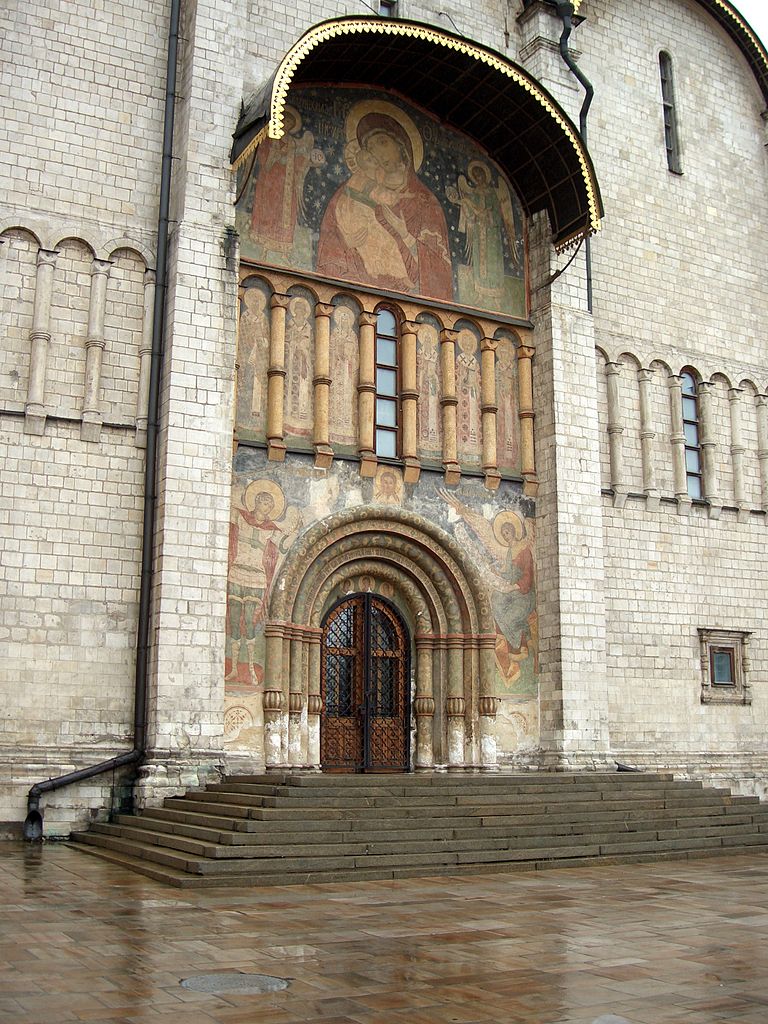
Royal Procession door on the Cathedral. Entry doors to Dormition Cathedral, Moscow Kremlin.

Anointing of Tsar Nicholas II of Russia during his coronation in 1896

Russian Regalia

Russian regalia used prior to the Great Imperial Crown. The crown is styled after the Monomakh Cap, and was made for Tsar Michael Fyodorovich by Kremlin masters in 1627. The orb and sceptre are of Western-European origin and may have been given to Tsar Boris Godunov in 1604.

Entry of Tsar Alexander II and his entourage into Moscow for his coronation, 1856

Procession of Tsar Alexander II into Dormition Cathedral from the Red Porch during his coronation in 1856.
.jpg&container=blogger&gadget=a&rewriteMime=image%2F*)
Alexander III receiving the sceptre during his coronation in 1883
Portrait by the artist Georges Becker of the coronation of Tsar Alexander III and Empress Maria Fyodorovna, which took place on 27 May [O.S. 15 May] 1883 at the Uspensky Sobor of the Moscow Kremlin. On the left of the dais can be seen his young son and heir, the Tsesarevich Nicolas, and behind Nicholas can be seen a young Grand Duke George.

Crowning of Tsaritsa Maria Alexandrovna.(Crowning of the Empress)

Homage from the imperial Family to Alexander II

Alexander II bows to his people atop the Kremlin's Red Staircase


Coronation banquet of Tsar Alexander II (1856) in the main hall of the Palace of Facets


Patriarch Nikon and Tsar Alexis in the Cathedral of the Archangel
en:Alexander Litovchenko (1835-90). Young en:Tsar Alexis Praying Before the Relics of en:Metropolitan Philip in the Presence of en:Patriarch Nikon.

The Inauguration of the Academy of Arts, a painting by Valery Jacobi

Peter the Great(1682-1725) by Paul Delaroche

Catherine the Great with the Great Imperial Crown to her right. Painting by Alexei Antropov, ca. 1765.
-VIDEO :CATHERINE THE GREAT Playlist - HD - English subtitles.

Portrait of Alexander III (1845-1894), the Russian Tsar, oil on canvas

Tsar Nicholas II, in the uniform of a Royal Navy Admiral of the Fleet, c. 1909Gelatin silver print photograph of Nicholas II, Emperor of Russia. He is standing with his left hand resting on a bicorn hat on the decorative table beside him to the right. He is wearing an ornate naval uniform including epaulets, a sash and insignia. There is a pair of white gloves in his right hand and a sword by his side.
Nicholas II (Russian: Николай II, Николай Александрович Романов, tr. Nikolai II, Nikolai Alexandrovich Romanov [nʲɪkɐˈlaj ftɐˈroj, nʲɪkɐˈlaj ɐlʲɪˈksandrəvʲɪtɕ rɐˈmanəf]) (18 May [O.S. 6 May] 1868 – 17 July 1918) was the last Emperor of Russia, Grand Duke of Finland, and titular King of Poland. His official short title was Tsar Nicholas II, Emperor and Autocrat of All the Russias. Like other Russian Emperors he is commonly known by the monarchical title Tsar (though Russia formally ended the Tsardomin 1721). He is known as Saint Nicholas the Passion-Bearer by the Russian Orthodox Church and has been referred to as Saint Nicholas the Martyr.
Nicholas II ruled from 1 November 1894 until his forced abdication on 15 March 1917. His reign saw Imperial Russia go from being one of the foremost great powers of the world to economic and military collapse. Political enemies nicknamed him Nicholas the Bloody because of the Khodynka Tragedy, anti-Semitic pogroms, Bloody Sunday, his violent suppression of the 1905 Revolution, his execution of political opponents and his perceived responsibility for the Russo-Japanese War.
Under his rule, Russia was decisively defeated in the Russo-Japanese War, which saw the annihilation of the Russian Baltic Fleet at the Battle of Tsushima. The Anglo-Russian Entente, designed to counter German attempts to gain influence in the Middle East, ended the Great Game between Russia and the United Kingdom. As head of state, Nicholas approved the Russian mobilisation of August 1914, which marked the beginning of Russia's involvement in the First World War, a war in which 3.3 million Russians were killed. The Imperial Army's severe losses and the High Command's incompetent handling of the war, along with other policies directed by Nicholas during his reign, are often cited as the leading causes of the fall of the Romanov dynasty.[citation needed]
Nicholas II abdicated following the February Revolution of 1917 during which he and his family were imprisoned first in the Alexander Palace at Tsarskoye Selo, then later in the Governor's Mansion in Tobolsk, and finally at the Ipatiev House in Yekaterinburg. In the spring of 1918, Nicholas was handed over to the local Ural soviet by commissar Vasili Yakovlev who was given a written receipt. Nicholas II, his wife, Alexandra Feodorovna, his son, Alexei Nikolaevich, his four daughters, Olga Nikolaevna, Tatiana Nikolaevna, Maria Nikolaevna and Anastasia Nikolaevna, the family's medical doctor, Evgeny Botkin, the Emperor's footman, Alexei Trupp, the Empress' maidservant, Anna Demidova, and the family's cook, Ivan Kharitonov, were executed in the same room by the Bolsheviks on the night of 16/17 July 1918.
This led to the canonisation of Nicholas II, his wife the Empress Alexandra and their children as passion bearers, a title commemorating believers who face death in a Christ-like manner,on 15 August 2000 by the Russian Orthodox Church within Russia and, in 1981, as martyrs by the Russian Orthodox Church Outside Russia, located in New York City
-VIDEO :Russia - Land of the Tsars_playlist.

-VIDEO :Visit to State Tretyakov Gallery Moscow
The gallery's history starts in 1856 when the Moscow merchant Pavel Mikhailovich Tretyakov acquired works by Russian artists of his day with the aim of creating a collection, which might later grow into a museum of national art. In 1892, Tretyakov presented his already famous collection of approximately 2,000 works (1,362 paintings, 526 drawings, and 9 sculptures) to the Russian nation.
The façade of the gallery building was designed by the painter Viktor Vasnetsov in a peculiar Russian fairy-tale style. It was built in 1902–04 to the south from the Moscow Kremlin. During the 20th century, the gallery expanded to several neighboring buildings, including the 17th-century church of St. Nicholas in Tolmachi.
The collection contains more than 130,000 exhibits, ranging from Theotokos of Vladimir and Andrei Rublev's Trinity to the monumental Composition VII by Wassily Kandinskyand the Black Square by Kazimir Malevich.
In 1977 the Gallery kept a significant part of the George Costakis collection.
In May 2012, the Tretyakov Art Gallery played host to the prestigious FIDE World Chess Championship between Viswanathan Anand and Boris Gelfand as the organizers felt the event would promote both chess and art at the same time
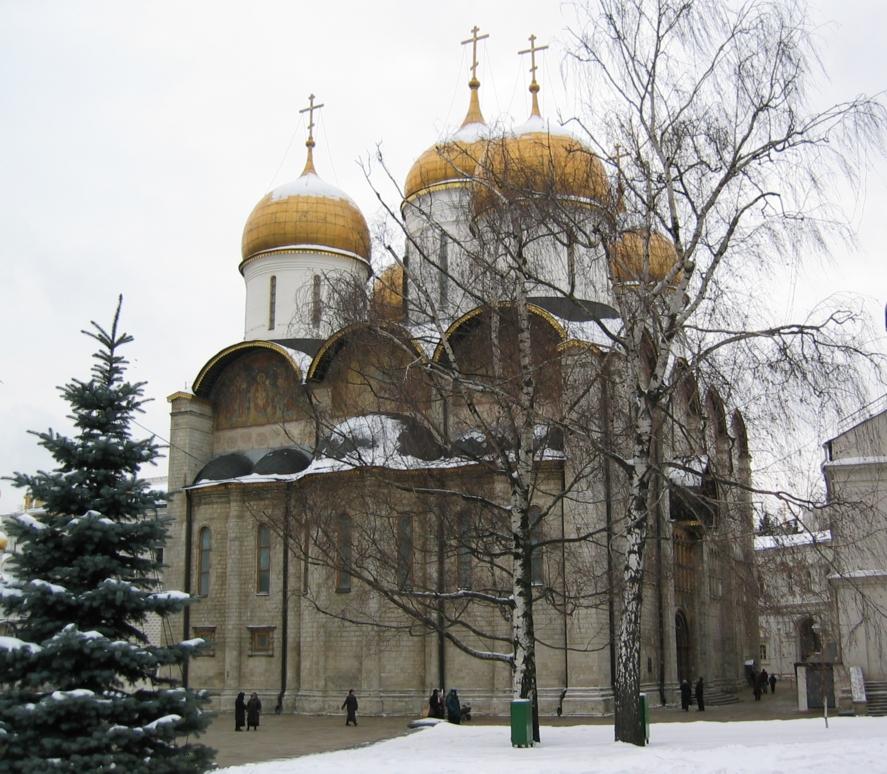 The Cathedral of the Dormition, Moscow Kremlin (east façade, winter).
The Cathedral of the Dormition, Moscow Kremlin (east façade, winter).
 The Cathedral of the Dormition, Moscow Kremlin (east façade, winter).
The Cathedral of the Dormition, Moscow Kremlin (east façade, winter).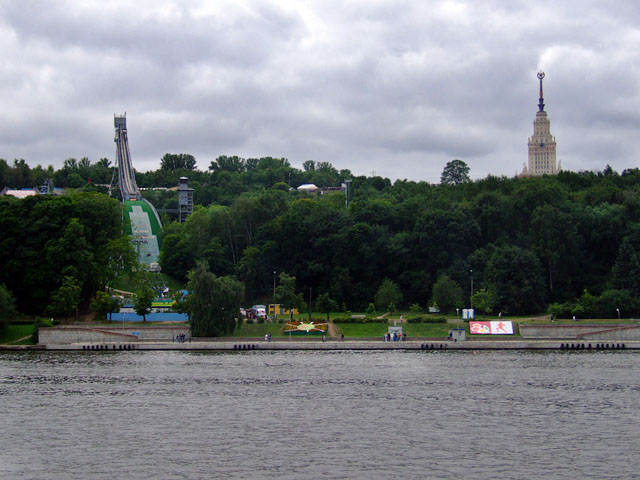
A view of Sparrow Hills from the Luzhetskaya Embankment

Lomonosov Moscow State University (MSU; Russian: Московский государственный университет имени М. В. Ломоносова) is a coeducational and public research university located in Moscow, Russia. It wasfounded on January 25, 1755 by Mikhail Lomonosov. MSU was renamed after Lomonosov in 1940 and was then known as Lomonosov University. It also claims to house the tallest educational building in the world. Its current rector is Viktor Sadovnichiy.

metro Arbatskaya (Filyovskaya Line), Arbatskaya Square, Moscow, pentagonal building
The Moscow Metro (Russian: Моско́вский метрополите́н, tr. Moskovsky metropoliten; IPA: [mɐˈskofskʲɪj mʲɪtrəpəlʲɪˈtɛn]) is a rapid transit system serving Moscow, Russia and the neighbouring Moscow Oblast towns of Krasnogorsk, Reutov and Kotelniki. Opened in 1935 with one 11-kilometre (6.8 mi) lineand 13 stations, it was the first underground railway system in the Soviet Union. As of 2015, the Moscow Metro has 197 stations (Baumanskaya station is closed for repairs) and its route length is 329 km (204 mi). The system is mostly underground, with the deepest section 74 metres (243 ft) underground at the Park Pobedy station, one of the world's deepest. As of 2013, the Moscow Metro is the busiest metro system outside of Asia and the 6th longest in the world.


Sokolniki station. Opened in 1935 (the first stage)

Mayakovskaya station. Opened in 1938 (the second stage)

Elektrozavodskaya station. Opened in 1944 (the third stage)

Kiyevskaya (Koltsevaya Line). Opened in 1954 (the fourth stage).Kievskaya-Koltsevaya Moscow Metro station.


Octagonal bell-tower (1689–90).Moscow, Russia. Novodevichy Convent. Bell Tower.

Novodevichy Convent, Moscow
Novodevichy Convent, also known as Bogoroditse-Smolensky Monastery (Russian: Новоде́вичий монасты́рь, Богоро́дице-Смоле́нский монасты́рь), is probably the best-known cloister of Moscow. Its name, sometimes translated as the New Maidens' Monastery, was devised to differ from an ancient maidens' convent within the Moscow Kremlin. Unlike other Moscow cloisters, it has remained virtually intact since the 17th century. In 2004, it was proclaimed a UNESCO World Heritage Site.

Novodevichy Convent at night, Moscow, Russia
“Dzerzhinsky Square”. Dzerzhinsky Square in Moscow.Dzerzhinsky Square 1966, with the Dzerzhinsky statue.

The Bolshoi Theatre is a historic theatre in Moscow, Russia, designed by architectJoseph Bové, which holds performances of ballet and opera. The theatre's original name was the Imperial Bolshoi Theatre of Moscow, while the St. Petersburg Bolshoi Theatre (demolished in 1886), was called the Imperial Bolshoi Kamenny Theatre.
At that time, all Russian theatres were imperial property. Moscow and St. Petersburg each had only two theatres, one intended for opera and ballet (these were known as the Bolshoi Theatres), and one for plays (tragedies and comedies). Because opera and ballet were considered nobler than drama, the opera houses were named "Grand Theatres" ("Bolshoi" is Russian for "large" or "grand") and the drama theatres were called the "Smaller Theatre" ("Maly" is Russian for "small", "lesser", or "little").
The Bolshoi Ballet and Bolshoi Opera are amongst the oldest and most renowned ballet and opera companies in the world. It is by far the world's biggest ballet company, having more than 200 dancers. The theatre is the parent company of The Bolshoi Ballet Academy, a world-famous leading school of ballet. It has a branch at the Bolshoi Theatre School in Joinville, Brazil.
The main building of the theatre, rebuilt and renovated several times during its history, is a landmark of Moscow and Russia (its iconic neoclassical facade is depicted on theRussian 100-ruble banknote). On 28 October 2011, the Bolshoi was re-opened after an extensive six-year renovation.The official cost of the renovation is 21 billion rubles ($688 million). However, other Russian authorities and other people connected to it claimed much more public money was spent. The renovation included restoring acoustics to the original quality (which had been lost during the Soviet Era), as well as restoring the original Imperial decor of the Bolshoi.
Bolshoi Theatre in 2006 before the renovation


Performance in the Bolshoi Theatre (1856)

Alexander III of Russia and his family at the Bolshoi, 1883

Auditorium of the Bolshoi Theatre .Moscow, Russia: Inside the Bolshoi Theatre, 10 April 2005. Taken during the break of Tchaikovsky's Nutcracker ballet.

Quadriga. Bolshoi Theatre. Moscow. Russia.The quadriga was sculpted by Peter Clodt von Jürgensburg

The central figure on this square is a monument of soviet poet - Vladimir Mayakovsky. Some famous theatres and big commercial companies are also located around the square that makes it important cultural and business landmark in the city.

GUM department store exterior facing Red Square

-VIDEO :BEHIND the CURTAIN: Life In the Soviet Union
.jpg)

Palace Square, Saint Petersburg
Palace Square backed by the General Staff arch and building, as the main square of the Russian Empire it was the setting of many events of historic significance
Saint Petersburg (Russian: Санкт-Петербу́рг, tr. Sankt-Peterburg; is the second largest city in Russia. It is politically incorporated as a federal subject (a federal city). It is located on the Neva River at the head of the Gulf of Finland on the Baltic Sea. In 1914 the name of the city was changed from Saint Petersburg to Petrograd (Russian: Петрогра́д; IPA: [pʲɪtrɐˈgrat]), in 1924 to Leningrad (Russian: Ленингра́д; IPA: [lʲɪnʲɪnˈgrat]), and in 1991, back to Saint Petersburg. In Russian literature, informal documents, and discourse, the word "Saint" is usually omitted, leaving "Petersburg". In casual conversation Russians may drop the "burg" as well, referring to it as "Piter".
Saint Petersburg was founded by Tsar Peter the Great on May 27 [O.S. 16] 1703. Between 1713–1728 and 1732–1918, Saint Petersburg was the imperial capital of Russia. In 1918, the central government bodies moved from Saint Petersburg (then named Petrograd) to Moscow. It is Russia's 2nd largest city after Moscow with 5 million inhabitants (2012) and the fourth most populated federal subject.Saint Petersburg is a major European cultural center, and also an important Russian port on the Baltic Sea.
Saint Petersburg is often described as the most Westernized city of Russia, as well as its cultural capital. It is the northernmost city in the world with a population of over one million.The Historic Centre of Saint Petersburg and Related Groups of Monuments constitute a UNESCO World Heritage Site. Saint Petersburg is also home to The Hermitage, one of the largest art museums in the world. A large number of foreign consulates, international corporations, banks, and other businesses are located in Saint Petersburg.
 The Neva River flows through much of the centre of the city. Left – the Spit of Vasilievsky Island, center – River Neva, Peter and Paul Fortress and Trinity Bridge, right – Palace Embankmentwith the Winter Palace
The Neva River flows through much of the centre of the city. Left – the Spit of Vasilievsky Island, center – River Neva, Peter and Paul Fortress and Trinity Bridge, right – Palace Embankmentwith the Winter Palace
 The Bronze Horseman, monument to Peter the Great
The Bronze Horseman, monument to Peter the Great
The Bronze Horseman at Senatskaya Square in Saint Petersburg, Russia
 Saint Petersburg (Admiralty building and spire in foreground) long served as the capital of the Russian Empire
Saint Petersburg (Admiralty building and spire in foreground) long served as the capital of the Russian Empire
View on Admiralty from Saint Isaac's Cathedral in Saint Petersburg (Russia). 19th-century photochrome print (1890—1900)



The golden-domed Saint Isaac's Cathedral dominates the city skyline
Cathedral of the Resurrection ("Savior on the Blood") (St. Petersburg and the Leningrad Region, St. Petersburg, Griboyedov Canal Embankment


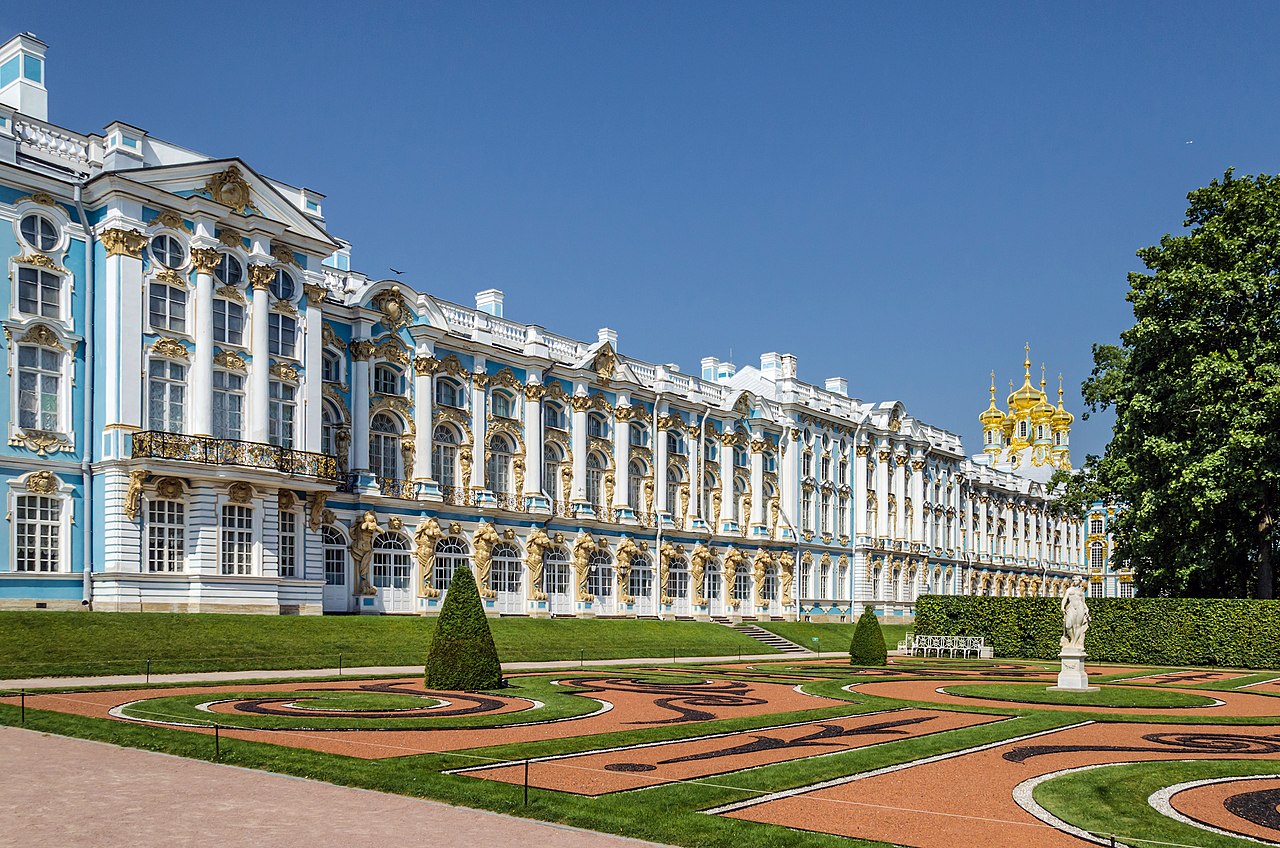
Catherine Palace in Tsarskoe Selo, Saint Petersburg
The Catherine Palace (Russian: Екатерининский дворец) is a Rococo palace located in the town of Tsarskoye Selo (Pushkin), 25 km south of St. Petersburg, Russia. It was the summer residence of the Russian stars.
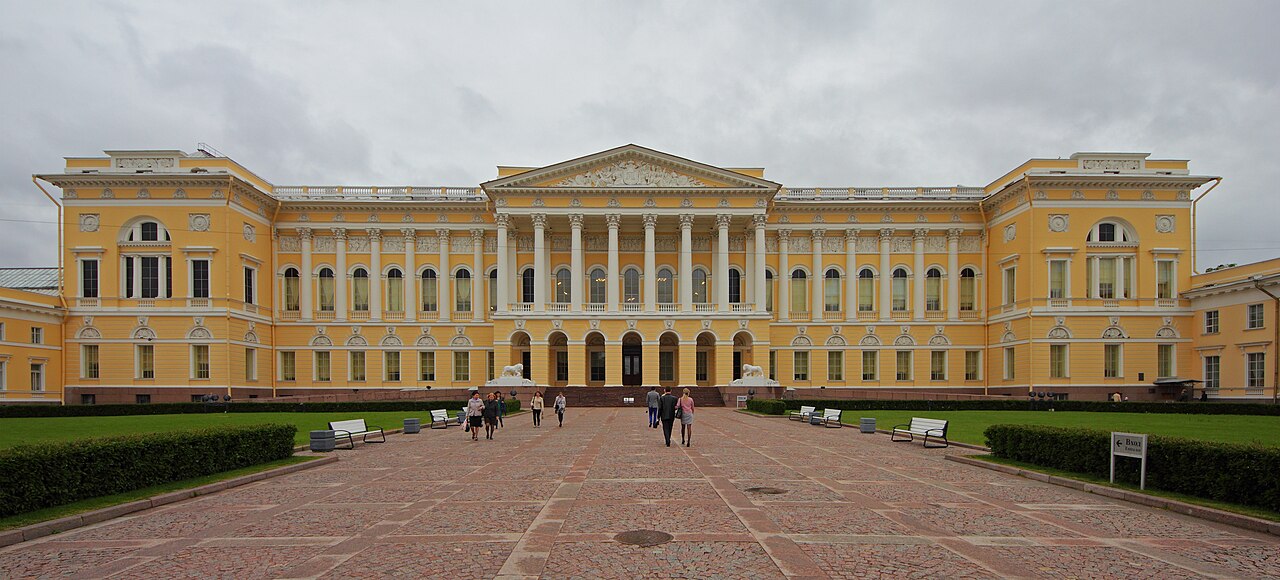 The Russian Museum._Saint Petersburg, Russia. Michael Palace (Main building of the Russian Museum).
The Russian Museum._Saint Petersburg, Russia. Michael Palace (Main building of the Russian Museum).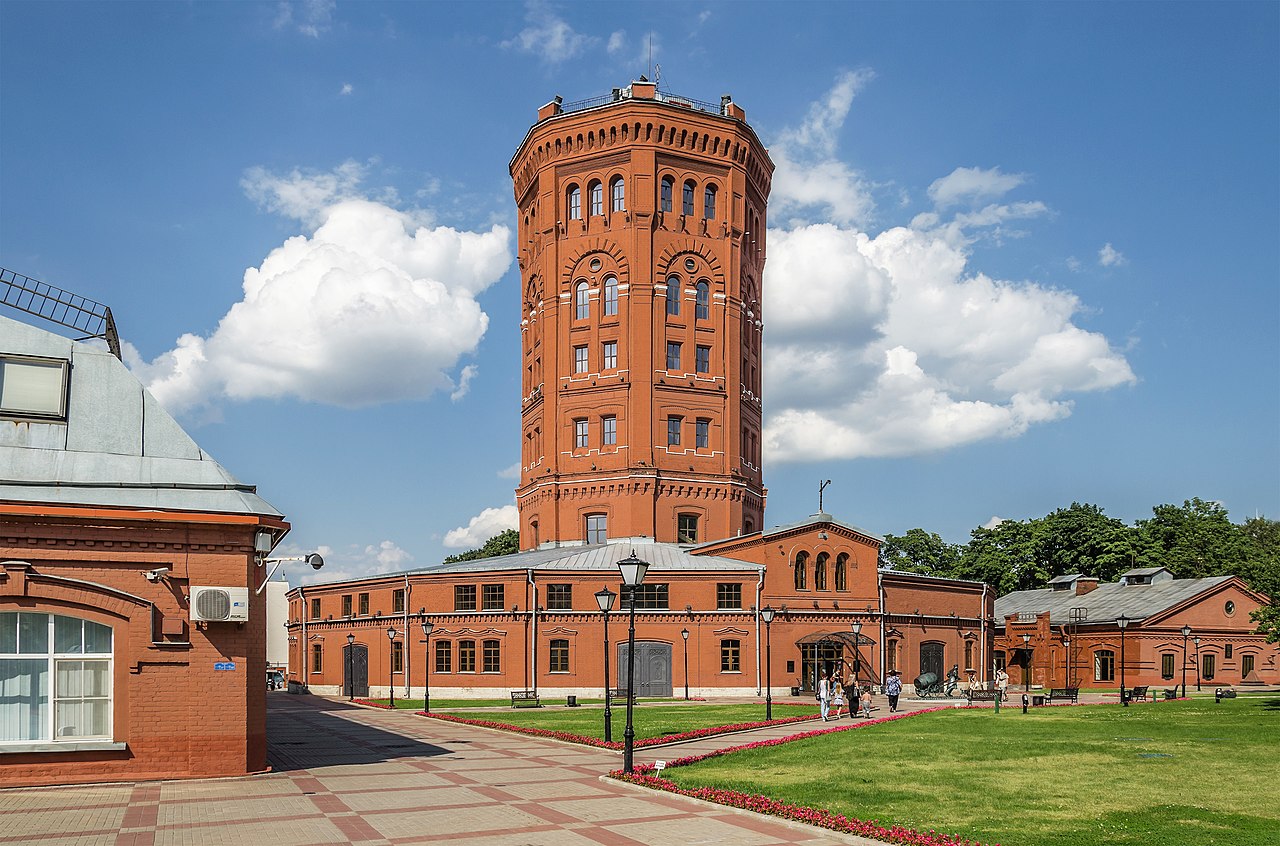

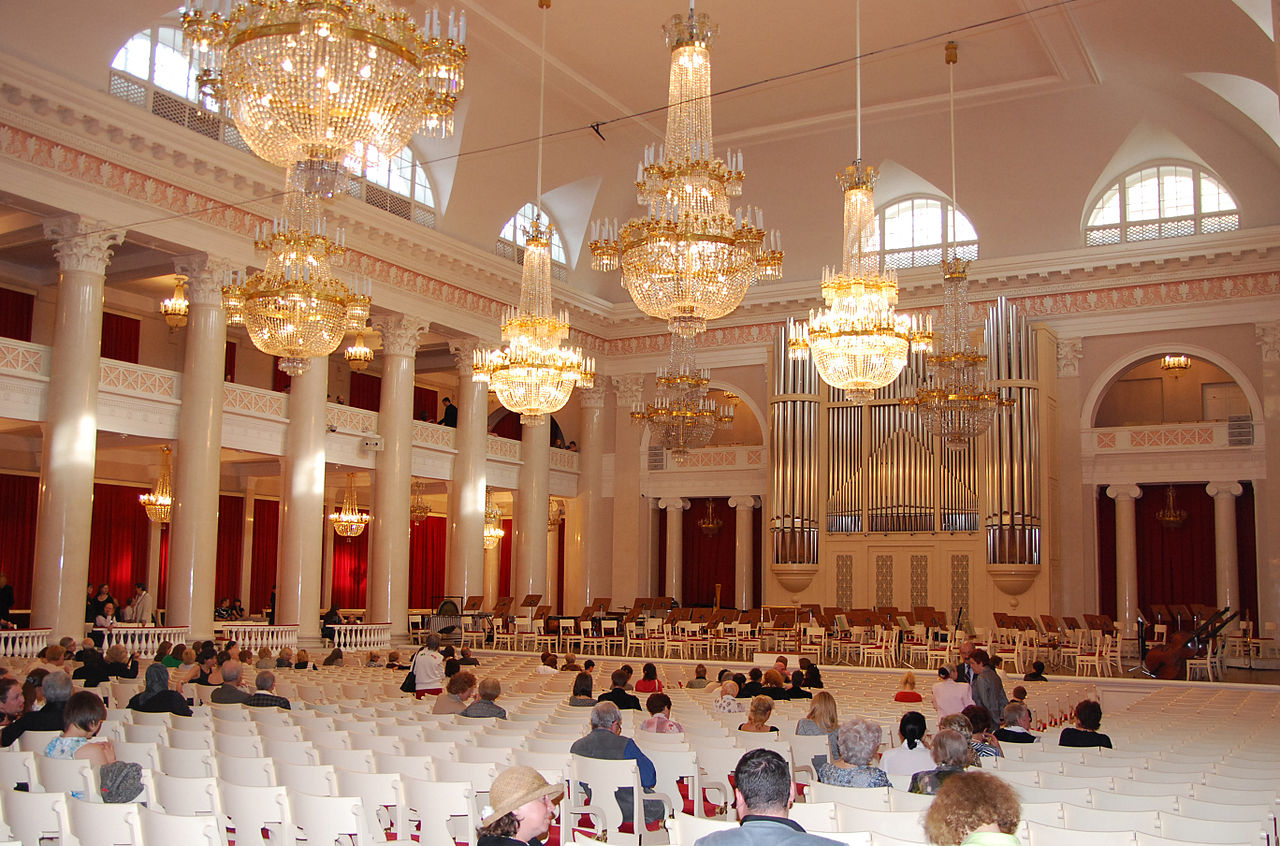
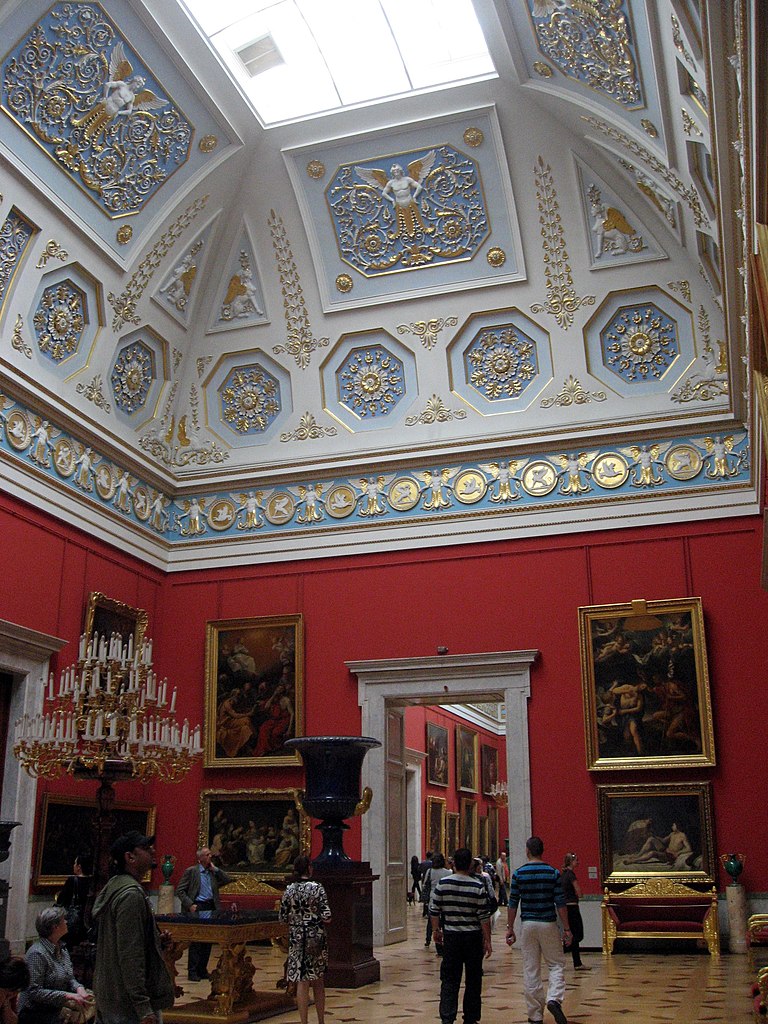
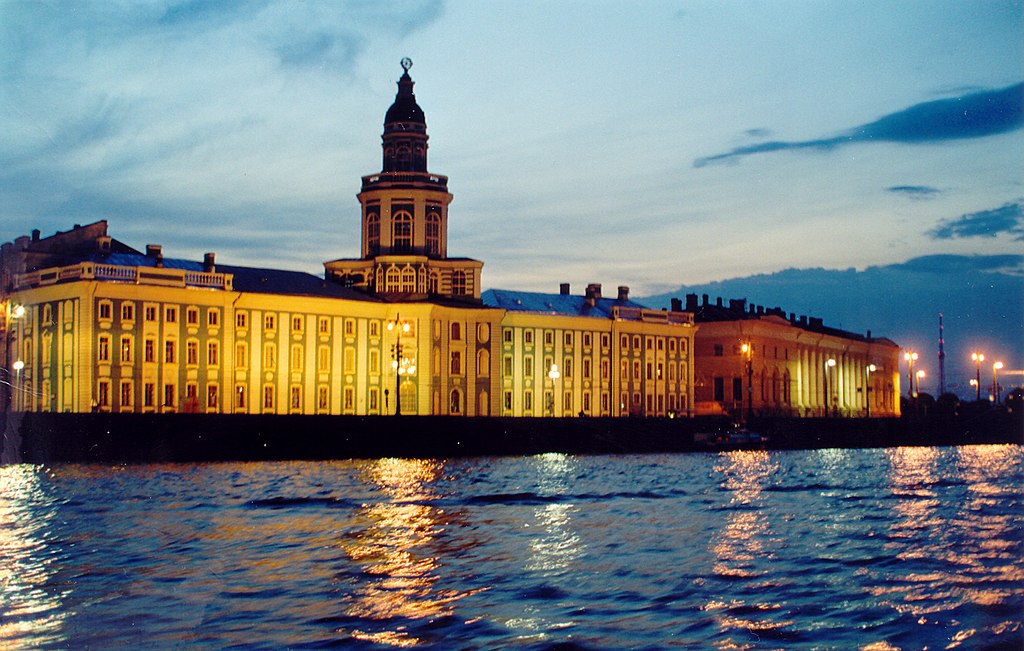

 Alexandrinsky Theatre in Saint Petersburg(2014)
Alexandrinsky Theatre in Saint Petersburg(2014)
The Alexandrinsky Theatre (Russian: Александринский театр) or Russian State Pushkin Academy Drama Theater (Российский государственный академический театр драмы им. А. С. Пушкина) is a theatre in Saint Petersburg, Russia.
The Alexandrinsky Theatre was built for the Imperial troupe of Petersburg (Imperial troupe was founded in 1856).
The theatre was opened on 31 August (12 September), 1832.
Since 1832, the theatre has occupied an Empire-style building that Carlo Rossi designed. It was built in 1828-1832 on Alexandrinsky Square (now Ostrovsky Square), which is situated on Nevsky Prospekt between the National Library of Russia and Anichkov Palace. The theatre and the square were named after Empress consort Alexandra Feodorovna. The building is part of the UNESCO World Heritage Site Historic Centre of Saint Petersburg and Related Groups of Monuments.
It was one of the many theatres of the Imperial troupe. Dramas, operas and ballets were on the stage. Only in 1880-ies, the theatre has become dramatic and tragedy filled.
The premières of numerous Russian plays have been performed at the stage of the Alexandrinsky, including plays by Alexandr Griboyedov, Alexander Ostrovsky, and Anton Chekhov. Famous directors who have staged work there include Vsevolod Meyerhold, Grigori Kozintsev, Georgy Tovstonogov, and Nikolay Akimov.
On 30 August 2006 the theatre reopened after a reconstruction.


 Ploshchad Pobedy (Victory Square) and panorama of Moskovskiy Prospekt
Ploshchad Pobedy (Victory Square) and panorama of Moskovskiy Prospekt
Monument to the Heroic Defenders of Leningrad
This powerful and impressive monument was built as the focal point of Ploshchad Pobedy (Victory Square) in the early 1970s to commemorate the heroic efforts of the residents of Leningrad and the soldiers on the Leningrad Front to the repel the Nazis in the 900-day Siege of Leningrad during World War II.
 Narva Triumphal Gate on Ploshchad StachekThe Narva Triumphal Arch was erected as a memorial to the war of 1812. A wooden triumphal arch designed according to the plan of famous Italian classical architect Dzhakomo Quarenghi. Quarenghi also built the Concert Hall pavilion (1782-88), Alexander Palace in Pushkin (1792-1800) and the Smolny Institute (1806-08) in St. Petersburg. The Narva Triumphal Arch was specially constructed on the Narva highway to greet the soldiers who were returning from abroad after their victory over Napoleon. The arch was located approximately halfway between Ploshchad Stachek and Obvodny Canal.
Narva Triumphal Gate on Ploshchad StachekThe Narva Triumphal Arch was erected as a memorial to the war of 1812. A wooden triumphal arch designed according to the plan of famous Italian classical architect Dzhakomo Quarenghi. Quarenghi also built the Concert Hall pavilion (1782-88), Alexander Palace in Pushkin (1792-1800) and the Smolny Institute (1806-08) in St. Petersburg. The Narva Triumphal Arch was specially constructed on the Narva highway to greet the soldiers who were returning from abroad after their victory over Napoleon. The arch was located approximately halfway between Ploshchad Stachek and Obvodny Canal.

Grand Peterhof Palace and the Grand Cascade.
The Peterhof Palace (Russian: Петерго́ф; IPA: [pʲɪtʲɪrˈɡof], Dutch for Peter's Court) is a series of palaces and gardens located in Petergof, Saint Petersburg, Russia, laid out on the orders of Peter the Great. These palaces and gardens are sometimes referred as the "Russian Versailles". The palace-ensemble along with the city center is recognized as a UNESCO World Heritage Site.

The Grand Cascade at Peterhof.

Peterhof: the Samson Fountain and Sea Channel.

French style interior.The Peterhof Palace

A portion of the Grand Cascade

Samson and the Lion, by Mikhail Kozlovsky

The Upper Gardens of Peterhof

Another view of the Grand Cascade

Poseidon and a dome at the palace
Grand Cascade in Peterhof
-VIDEO :Peterhof - The Russian Versailles - Part 1
-Peterhof - The Russian Versailles - Part 2

Lower Park With Canal And Golden Statues Of The Peterhof. Russia .

The Peterhof Palaces with its gardens, located in Saint Petersburg, laid out on the orders of Peter the Great are sometimes referred as the "Russian Versailles"


-VIDEO : St. Petersburg, Russia (2013)
-VIDEO :St Petersburg Vacation Travel Video Guide.Great Destinations(2015)
After the maritime victory over the Swedish army, Peter I the Great decided that he is going to build a city on the small islands and lagoons of the mouth of the river Neva. The Russian, Italian and French masters dreamed wonderful Baroque and Classicist palaces to the banks of the canals. The Church of the Savior on Blood, the Saint Isaac's Cathedral, the Peter and Paul Fortress, the blue white and gold Smolny and the Winter Palace all make the city of white nights unforgettable. The Hermitage has one of the largest art collections of the world, but for those who find this less than enough, there is the Russian Museum, and the suburbs of Peterhof, Pushkin and Pavlovsk.
-VIDEO :Cathedral of the Resurrection in St. Petersburg, Russia_(2015)or "The Savior on the Spilled Blood", in Saint Petersburg, Russia.
The Church of the Savior on Spilled Blood (Russian: Церковь Спаса на Крови, Tserkovʹ Spasa na Krovi) is one of the main sights of St. Petersburg,Russia. It is also variously called the Church on Spilt Blood (Russian: Церковь на Крови, Tserkov’ na Krovi) and the Cathedral of the Resurrection of Christ(Russian: Собор Воскресения Христова, Sobor Voskreseniya Khristova), its official name._ St. Petersburg, Russia

The Church of Our Savior, St. Petersburg, Russia.
-VIDEO :St. Petersburg, Russia Shore Excursion(2011)
-VIDEO :Russian Popular Music (oldies): Alla Pugacheva - "Million Scarlet Roses"_Playlist

-Visiting RUSSIA :( Jun 3, 2017)

“Dzerzhinsky Square”. Dzerzhinsky Square in Moscow.Dzerzhinsky Square 1966, with the Dzerzhinsky statue.

The Bolshoi Theatre is a historic theatre in Moscow, Russia, designed by architectJoseph Bové, which holds performances of ballet and opera. The theatre's original name was the Imperial Bolshoi Theatre of Moscow, while the St. Petersburg Bolshoi Theatre (demolished in 1886), was called the Imperial Bolshoi Kamenny Theatre.
At that time, all Russian theatres were imperial property. Moscow and St. Petersburg each had only two theatres, one intended for opera and ballet (these were known as the Bolshoi Theatres), and one for plays (tragedies and comedies). Because opera and ballet were considered nobler than drama, the opera houses were named "Grand Theatres" ("Bolshoi" is Russian for "large" or "grand") and the drama theatres were called the "Smaller Theatre" ("Maly" is Russian for "small", "lesser", or "little").
The Bolshoi Ballet and Bolshoi Opera are amongst the oldest and most renowned ballet and opera companies in the world. It is by far the world's biggest ballet company, having more than 200 dancers. The theatre is the parent company of The Bolshoi Ballet Academy, a world-famous leading school of ballet. It has a branch at the Bolshoi Theatre School in Joinville, Brazil.
The main building of the theatre, rebuilt and renovated several times during its history, is a landmark of Moscow and Russia (its iconic neoclassical facade is depicted on theRussian 100-ruble banknote). On 28 October 2011, the Bolshoi was re-opened after an extensive six-year renovation.The official cost of the renovation is 21 billion rubles ($688 million). However, other Russian authorities and other people connected to it claimed much more public money was spent. The renovation included restoring acoustics to the original quality (which had been lost during the Soviet Era), as well as restoring the original Imperial decor of the Bolshoi.
Bolshoi Theatre in 2006 before the renovation


Performance in the Bolshoi Theatre (1856)

Alexander III of Russia and his family at the Bolshoi, 1883

Auditorium of the Bolshoi Theatre .Moscow, Russia: Inside the Bolshoi Theatre, 10 April 2005. Taken during the break of Tchaikovsky's Nutcracker ballet.

Quadriga. Bolshoi Theatre. Moscow. Russia.The quadriga was sculpted by Peter Clodt von Jürgensburg

-VIDEO :!!!Full Version!!! The Bolshoi Theater Opening 28.10.2011 + Bonus !
Triumfalnaya Square:
The central figure on this square is a monument of soviet poet - Vladimir Mayakovsky. Some famous theatres and big commercial companies are also located around the square that makes it important cultural and business landmark in the city.
-VIDEO :Popular Moscow International Business Center & Moscow videos
_Playlist.

GUM department store exterior facing Red Square
-VIDEO :Popular GUM & Moscow videos_playlist.
Москва-1964:
-VIDEO :BEHIND the CURTAIN: Life In the Soviet Union
1964_Moscow.

ГУМ_(GUM)_1964.
Moscow is the capital city and the most populous city of USSR.
Soviet Era Museum present a great panoramic photo story about of Soviet Moscow-1960s’:
Soviet Era Museum present a great panoramic photo story about of Soviet Moscow-1960s’:
.jpg)
-VIEW :Soviet Union 60-70s_PHOTOS
Some of what I saw in the Soviet Union 60-70s American photographer Dean Conger.
View of the Kremlin, 1967
View of the Kremlin, 1967
" IRON CURTAIN LANDS " 1959 POST-STALIN ERA SOVIET UNION & EASTERN EUROPE.

Palace Square, Saint Petersburg
Palace Square backed by the General Staff arch and building, as the main square of the Russian Empire it was the setting of many events of historic significance
Saint Petersburg (Russian: Санкт-Петербу́рг, tr. Sankt-Peterburg; is the second largest city in Russia. It is politically incorporated as a federal subject (a federal city). It is located on the Neva River at the head of the Gulf of Finland on the Baltic Sea. In 1914 the name of the city was changed from Saint Petersburg to Petrograd (Russian: Петрогра́д; IPA: [pʲɪtrɐˈgrat]), in 1924 to Leningrad (Russian: Ленингра́д; IPA: [lʲɪnʲɪnˈgrat]), and in 1991, back to Saint Petersburg. In Russian literature, informal documents, and discourse, the word "Saint" is usually omitted, leaving "Petersburg". In casual conversation Russians may drop the "burg" as well, referring to it as "Piter".
Saint Petersburg was founded by Tsar Peter the Great on May 27 [O.S. 16] 1703. Between 1713–1728 and 1732–1918, Saint Petersburg was the imperial capital of Russia. In 1918, the central government bodies moved from Saint Petersburg (then named Petrograd) to Moscow. It is Russia's 2nd largest city after Moscow with 5 million inhabitants (2012) and the fourth most populated federal subject.Saint Petersburg is a major European cultural center, and also an important Russian port on the Baltic Sea.
Saint Petersburg is often described as the most Westernized city of Russia, as well as its cultural capital. It is the northernmost city in the world with a population of over one million.The Historic Centre of Saint Petersburg and Related Groups of Monuments constitute a UNESCO World Heritage Site. Saint Petersburg is also home to The Hermitage, one of the largest art museums in the world. A large number of foreign consulates, international corporations, banks, and other businesses are located in Saint Petersburg.


The Bronze Horseman at Senatskaya Square in Saint Petersburg, Russia

View on Admiralty from Saint Isaac's Cathedral in Saint Petersburg (Russia). 19th-century photochrome print (1890—1900)

View from the Colonnade, St. Isaac's Cathedral, Saint Petersburg


The golden-domed Saint Isaac's Cathedral dominates the city skyline
Cathedral of the Resurrection ("Savior on the Blood") (St. Petersburg and the Leningrad Region, St. Petersburg, Griboyedov Canal Embankment
-VIDEO :Inside The Church Of Our Savior On Spilled Blood - Saint Petersburg, Russia.
The Church Of Our Savior on Spilled Blood contains over 7500 square meters of mosaics—according to its restorers, more than any other church in the world. The interior was designed by some of the most celebrated Russian artists of the day—including Viktor Vasnetsov, Mikhail Nesterov and Mikhail Vrubel — but the church's chief architect, Alfred Alexandrovich Parland, was relatively little-known (born in St. Petersburg in 1842 in a Baltic-German Lutheran family). Perhaps not surprisingly, the Church's construction ran well over budget, having been estimated at 3.6 million rubles but ending up costing over 4.6 million. The walls and ceilings inside the Church are completely covered in intricately detailed mosaics — the main pictures being biblical scenes or figures — but with very fine patterned borders setting off each picture. It is absolutely stunning to behold in person.-VIDEO :St. Petersburg - Church of the Savior on Blood_(2015)


Saint Petersburg, Russia. Nevsky Avenue. Kazan Cathedral.

Catherine Palace in Tsarskoe Selo, Saint Petersburg
The Catherine Palace (Russian: Екатерининский дворец) is a Rococo palace located in the town of Tsarskoye Selo (Pushkin), 25 km south of St. Petersburg, Russia. It was the summer residence of the Russian stars.
-VIEW :Catherine the Great's TSARSKOYE SELO
-VIDEO :Imperial Reception at Catherine Palace_2011
-VIDEO :St. Petersburg, Russia
 Catherine Palace in Tsarskoye Selo (Pushkin), south of St Petersburg, Russia
Catherine Palace in Tsarskoye Selo (Pushkin), south of St Petersburg, Russia
-VIDEO :Tsarskoe Selo (Pushkin Town), St Petersburg-Russia


Museum of Water_The Universe of Water Museum complex in Saint Petersburg


The Bolshoi Zal (Grand Hall) of Saint Petersburg Philharmonia
-VIDEO :Saint Petersburg - Walking Hermitage - Russia / 4К_2019.
Saint Petersburg, yachts on the Neva River.Saint Petersburg. Yachts on Neva river. On the second plan: a complex of buildings of theHermitage Museum (from right to left: the Winter palace, the Small Hermitage, the Old Hermitage with transitive gallery over the Winter canal, Hermitage theatre.
 Palace Square in winter. Winter Palace, Alexander Column, General Staff Building
Palace Square in winter. Winter Palace, Alexander Column, General Staff Building
-VIDEO : St Petersburg Hermitage Museum_2017.
The Hermitage Museum in St.Petersburg, Russia is one of the world s art museum. Its magnificent building served as the official residence of the Russian Emperors for almost two centuries.

-VIDEO : St Petersburg Hermitage Museum_2017.
The Hermitage Museum in St.Petersburg, Russia is one of the world s art museum. Its magnificent building served as the official residence of the Russian Emperors for almost two centuries.

The Small Italian Skylight Room in the Hermitage Museum

Saint Petersburg, Russia - White Nights with Kunstkammer


The Alexandrinsky Theatre (Russian: Александринский театр) or Russian State Pushkin Academy Drama Theater (Российский государственный академический театр драмы им. А. С. Пушкина) is a theatre in Saint Petersburg, Russia.
The Alexandrinsky Theatre was built for the Imperial troupe of Petersburg (Imperial troupe was founded in 1856).
The theatre was opened on 31 August (12 September), 1832.
Since 1832, the theatre has occupied an Empire-style building that Carlo Rossi designed. It was built in 1828-1832 on Alexandrinsky Square (now Ostrovsky Square), which is situated on Nevsky Prospekt between the National Library of Russia and Anichkov Palace. The theatre and the square were named after Empress consort Alexandra Feodorovna. The building is part of the UNESCO World Heritage Site Historic Centre of Saint Petersburg and Related Groups of Monuments.
It was one of the many theatres of the Imperial troupe. Dramas, operas and ballets were on the stage. Only in 1880-ies, the theatre has become dramatic and tragedy filled.
The premières of numerous Russian plays have been performed at the stage of the Alexandrinsky, including plays by Alexandr Griboyedov, Alexander Ostrovsky, and Anton Chekhov. Famous directors who have staged work there include Vsevolod Meyerhold, Grigori Kozintsev, Georgy Tovstonogov, and Nikolay Akimov.
On 30 August 2006 the theatre reopened after a reconstruction.

-VIDEO :Russian traditional folk dance
Classical Russian Ballet
Monument to the Heroic Defenders of Leningrad
This powerful and impressive monument was built as the focal point of Ploshchad Pobedy (Victory Square) in the early 1970s to commemorate the heroic efforts of the residents of Leningrad and the soldiers on the Leningrad Front to the repel the Nazis in the 900-day Siege of Leningrad during World War II.

Grand Peterhof Palace and the Grand Cascade.
The Peterhof Palace (Russian: Петерго́ф; IPA: [pʲɪtʲɪrˈɡof], Dutch for Peter's Court) is a series of palaces and gardens located in Petergof, Saint Petersburg, Russia, laid out on the orders of Peter the Great. These palaces and gardens are sometimes referred as the "Russian Versailles". The palace-ensemble along with the city center is recognized as a UNESCO World Heritage Site.

The Grand Cascade at Peterhof.

Peterhof: the Samson Fountain and Sea Channel.

French style interior.The Peterhof Palace

A portion of the Grand Cascade

Samson and the Lion, by Mikhail Kozlovsky

The Upper Gardens of Peterhof

Another view of the Grand Cascade

Poseidon and a dome at the palace
Grand Cascade in Peterhof
-VIDEO :Peterhof - The Russian Versailles - Part 1
-Peterhof - The Russian Versailles - Part 2
Lower Park With Canal And Golden Statues Of The Peterhof. Russia .
The Peterhof Palaces with its gardens, located in Saint Petersburg, laid out on the orders of Peter the Great are sometimes referred as the "Russian Versailles"
-VIDEO :St. Petersburg Palaces
Russia, St. Petersburg, Banking bridge on the Griboedov c
-VIDEO : St. Petersburg, Russia (2013)
-VIDEO :St Petersburg Vacation Travel Video Guide.Great Destinations(2015)
After the maritime victory over the Swedish army, Peter I the Great decided that he is going to build a city on the small islands and lagoons of the mouth of the river Neva. The Russian, Italian and French masters dreamed wonderful Baroque and Classicist palaces to the banks of the canals. The Church of the Savior on Blood, the Saint Isaac's Cathedral, the Peter and Paul Fortress, the blue white and gold Smolny and the Winter Palace all make the city of white nights unforgettable. The Hermitage has one of the largest art collections of the world, but for those who find this less than enough, there is the Russian Museum, and the suburbs of Peterhof, Pushkin and Pavlovsk.
-VIDEO :Cathedral of the Resurrection in St. Petersburg, Russia_(2015)or "The Savior on the Spilled Blood", in Saint Petersburg, Russia.
The Church of the Savior on Spilled Blood (Russian: Церковь Спаса на Крови, Tserkovʹ Spasa na Krovi) is one of the main sights of St. Petersburg,Russia. It is also variously called the Church on Spilt Blood (Russian: Церковь на Крови, Tserkov’ na Krovi) and the Cathedral of the Resurrection of Christ(Russian: Собор Воскресения Христова, Sobor Voskreseniya Khristova), its official name._ St. Petersburg, Russia
The Church of Our Savior, St. Petersburg, Russia.
-VIDEO :St. Petersburg, Russia Shore Excursion(2011)

-Russia's Lost Princesses Documentary 1/2:
-VIDEO :Siberia - Wild Russia GEO CHANNEL(2016)
-VIDEO :MONGOLIA(2012)Mongolia until now has been one of the world's best-kept secrets. Three times the size of France and with more horses than people; it is one Asia's last unspoilt destinations. Nomadic herders still roam the steppe, as they have since the time of ChinggisKhaan.
Watch Mongolia and prepare yourself for an invigorating experience. Immerse yourself in the staggering beauty and warm hospitality of Mongolia; Experience the vast epic landscapes and rich cultural and natural heritage of this wonderful country. You will be charmed by Lake Husvug, the Altai Mountains, the Gobi Desert, the Orgo volcano and Ulaanbaatar. You will be seduced by its welcoming nomads, their customs and traditions, spirituality and music. The spectacular Naddam Festival will have you packing your suitcase to discover this enchanting country yourself-VIDEO :-Natasha (Aubrey Hepburn) and Andre's First Waltz_Playlist.
-VIDEO :Russian Popular Music (oldies): Alla Pugacheva - "Million Scarlet Roses"_Playlist
360 VR Tour | Moscow | Grand Kremlin Palace | Residence of President
Putin | Inside |
-Visiting RUSSIA :( Jun 3, 2017)








